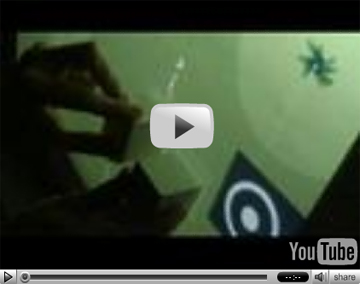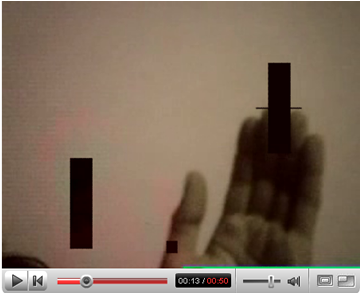July 06, 2007
Nina Czegledy reports on Media Forum 2007
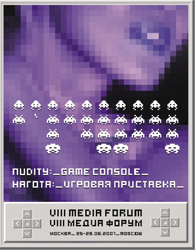
Nudity:_Game Console_
Between June 25-28, Media Forum, Moscow in collaboration with the Moscow International Film Festival, presented Nudity/Game console - a series of events including a Vito Accoinci retrospective, round table discussions and a video art competition. The theme of this year was: Nudity/Game console. The ERA Foundation hosted the Media Forum events in their centrally located, elegantly renovated gallery space.
In this report I would like to focus on the round table discussions - especially as the majority of the presenters happened to be women working with research & practice in digital fields/communities. Instead of lengthy descriptions, links are provided below for further information.
"Cultural cooperation online", the first discussion on June 26th was presented by Angela Plohman, content developer of Labforculture. The organization provides extremely useful tools for those in the arts who wish to collaborate across borders. The constructive, practical value of this information and knowledge platform was very much appreciated by the audience as attested by the numerous questions and comments.
On June 27, Anne Nigten of V2 lectured on "Research and development in the interdisciplinary field from an art perspective" followed by Dmitry Bulatov on "The third modern - denuding the media. The technobiological art work." Last but not least Margarete Jahrman showed us "Pong Dress" and Ludic Society. All of these presentations were very well received with lively Q&A periods.
Next day, June 28, "Super-Embodiment of Woman Artists in Media Arts" was presented by Irina Aristarkhova, Nina Czegledy and Elena Kovylina. Irina noted in her introduction that "Nudity and the Nude - have become key issues in contemporary art, theory and politics. Women artists face what Foucault called 'hysteriarization of female body', while men artists face an issue of 'absent male body' (Kelly Oliver) and respond to it with various strategies. One might argue that both Western and Eastern European women artists have exhibited 'too much body', and to a certain extent find it difficult to leave "body" behind. However, we rarely discuss what impact socialist gender policies and practices have had on this process within aesthetics. If performance art leaves us with legacy of 'too much body' - 'super-embodiment', - one wonders of it morphs into (new) media art as question of 'machine' / 'cyborg' embodiment and its identity."
In the course of our presentations both Irina and myself emphasized that feminism and gender issues can not be separated from the particular history of the region. Lack of clarification of this issue leads to numerous misconceptions and miscommunication. Case histories of media art were presented including "I am a robot" by Boryana Dragoeva Rossa (Bulgaria) and "Reality Resonance" by Erika Katalina Pasztor (Hungary), followed by the outstanding Russian performance artist Elena Kovylina, showing her "Pick a Girl" video performance featured at the Sydney Biennale 2006. The questions and comments at the end of our panel revealed that controversy and strife are still embedded in this discourse.
The schedule left room for us to visit some artists studios, participate in the mega-retrospective by Oleg Kulik and Vinzavod and old factory converted into a mixed use art center and luxury boutiques - where hopefully the Media Art Lab will have its future home. There is so much more including Art4 the private contemporary art museum, Moscow Rolls Royce, the electroboutique, traffic jams, night life etc. etc -worth a visit!
nina [via Spectre]
Posted by jo at 10:37 AM | Comments (0)
June 27, 2007
CADAVRE EXQUIS CARTOGRAPHY (C.E.C.)
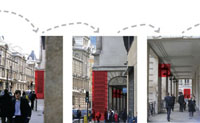
Urban Game & Mapping Exercise
FRIDAY SESSION 18 :: CADAVRE EXQUIS CARTOGRAPHY (C.E.C.); An urban game & mapping exercise followed by Talks from Dr. Maria Kaika and Julie Myers :: June 29, 2007; 6.30 pm :: Outside Bank Tube station - Take the 'Cornhill North' exit and meet us on the square outside the Royal Exchange, corner of Threadneedle St. and Cornhill :: Bring: a digital camera with its download equipment (Cables!), so we can download the images after the walk at Public Works and team-mates.
CADAVRE EXQUIS CARTOGRAPHY prompts people to explore and collect ground-level images of the City. Walks will be followed by two short talks at the public works studio at 8pm. Dr .Maria Kaika of Oxford University will talk on the continuously changing development of the City of London. Julie Myers will present - To travel Somewhere - a mobile phone / mapping project developed from a series of walks in San Francisco, USA, Cambridge, UK and Helsinki, FIN.
CADAVRE EXQUIS CARTOGRAPHY is played in pairs sharing one digital camera with display screen. Player 1 starts by taking a picture with a designated building or object in the frame as well as a second object / building of any kind. After handing over the camera to player 2, both leave the first photographed object behind, moving towards the second element of the shot. Player 2 now takes a picture with this building / object in the frame, but again with something else in the background or foreground, which will be the linking element in the next image. The camera is then handed over to player 1, who takes the next photo of the series.
THE AIM OF THE GAME IS TO COVER AS MUCH GROUND AS YOU CAN.
THE RULES:
1. A team is only allowed 30 shots and 1 camera per walk, so SHOOT CAREFULLY!
2. Images have to overlap physically and can only be of ground level building or object, so DON'T SHOOT IN THE AIR!
3. Only take images of objects/buildings in front of the team so SHOOT FORWARD!
All images will be assembled online and will allow visitors to wander through the City from behind their computer.
Maria Kaika holds a D.Phil. in Geography from the University of Oxford, and an MA in Architecture from the National Technical University of Athens as well as professional qualifications as an architect. Her previous posts include: Director of Studies in Human Geography at St Hugh's College, Oxford, Departmental Lecturer at the School of Geography, Oxford, Junior Research Fellow at Linacre College, Oxford, Lecturer in Human Geography at St Peter's College Oxford.
Dr Kaika's research focuses on urban theory, and more specifically on the politics and culture of architectural technology and design and on urban political ecology. Collaborative projects include work on: urbanism and culture; modernist urbanism and nature; urban environmental history; representations of nature and the city; governance and environmental policy; European environmental policy; theoretical approaches to sustainability; political ecology of water supply in western cities.
Julie Myers is an artist who's practice is informed by social encounter and intervention. Her work investigate memory, gesture and narrative in relation to physical environment. Sometimes recording just a brief moment captured between strangers and at other times building sustained relationship with multiple participants over a sustained period of time. She uses film/video, mobile technologies and database formats to document and present material that exists both on the web and in site specific or exhibition space.
Julie is a senor lecturer at Middlesex and Kingston Universities and lives in London. She has exhibited and screened work extensively receiving a number of awards including an AHRB research award and an Erasmus Scholarship. Previous work has been commissioned by The Arts Council of England, NESTA, The BFI, The Institute of Contemporary Art, BAA and the National Portrait Gallery. Julie has recently completed a placement at Adobe in San Francisco as part of the ACE interact program.
public works
Northgate House
2-8 Scrutton Street
UK London EC2A 4RT
Click here to view map
For more information email Jim[at]citymined.org or andreas[at]publicworksgroup.net
Posted by jo at 12:56 PM | Comments (0)
June 22, 2007
Canal Street Station

Participatory Public Pay Phone Who-Dunnit
31 Down's interactive telephone mystery Canal Street Station runs through October 31, 2007. To play, call this toll-free number from a pay phone inside the station: 1-877-OR-WHAT-31 (1-877-679-4283). Note: This mystery takes place on the N, Q, R, W, 6, and J, M, Z platforms, not the A, C, E, station.
Canal Street Station is a free public media art installation set in the Canal Street Subway Station in New York City. Participants are invited to make a toll-free call from any public payphone in the Canal Street station (inside of the turnstyles). Participants will then be guided on a pay phone mystery. The game takes approximately 45 minutes to complete.
Tajna Tanovic stars in this public pay phone who-dunnit set in the maze of tiles that make up the Canal Street Subway Station. This is an interactive piece that challenges participants to test their skills at listening and following directions. Players are put in the shoes of Mike Sharpie, private investigator, as he searches the depths of Canal Street Station for a young French woman that may have committed a murder, or may be a figment of Mike's wandering imagination.
"Canal Street Station" is co-produced by 31 Down radio theater and free103point9 and presented by free103point9 as part of the transmission arts non-profit's Tenth Anniversary celebration. Created by: Ryan Holsopple, Shannon Sindelar, Mirit Tal, and Tanja Tanovic.
Posted by newradio at 10:44 AM | Comments (0)
June 20, 2007
[iDC] game culture (?) (!) (%#@)
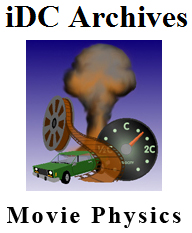
Game Physics
[...] I am at the beginning of some research into the area of game physics (that is, the simulation of physics in video games) ... The research is somewhat motivated by several observations:
Physics has an interesting split personality in that it is viewed as very fundamental in the sciences with a lot of 'prestige' (Einstein is a folk-hero), but at the same time Physics seems to be largely rejected as a discussion topic by non-science educated folks. As soon as it gets a bit more detailed and mathematical, most people will react try to avoid Physics. The current state of physics education (low number of graduates, etc.) confirms this.
Games on the other hand are well on the way (if not already there) to become the most used, most influential, most profitable entertainment medium. Therefore one can safely assume that they exert a significant influence on our culture. This trend which will continue in the years to come, especially as graphics capabilities reach photorealistic levels.
Game Physics is an element in video games that was always present and is even at the root of games (SpaceWar, the first video game was a physics simulation). It is becoming even more common due to the 3D and immersive nature of todays video games, because it makes games 'playable'. Generally it is a very important aspect of games since it is directly linked to the interactivity and 'feel' of the gameworld, but as a topic of game theoretical analysis, it is often overlooked.
As for some specific questions, I am currently interested in a discussion on how games affect the relationship we have with the real world. Obviously there are social implications to video game play as we can see from the whole "violence in games" debate. In relationship to Physics, I am looking at more fundamental changes in how we construct truths: Does video game physics create a form of "folk physics" (my immediate answer would be yes) and does that change the way we think or even act? For readers unfamiliar with video games, think of the 'Movie Physics' - which todays games largely adopt - such as the engine roar of a space ship flying by the camera (... this should be silent in vacuum).
So in some sense, the question extends the common "does it matter that movies have pseudo physics?" discussed extensively on site like http://www.intuitor.com/moviephysics/ to "does it matter when video games have pseudo physics?" (and believe me they do!). Why don't game developers try harder and game players expect more?
If one looks critically at mass media today, are we not creating a whole new "church of entertainment" especially with video games, where - at least as far as physical simulations are concerned - the scientific method and precision becomes irrelevant or at best secondary over the goal of implementing the next, better implementation of a game as 'VR drug' or 'consentual hallucinations' as W. Gibson puts it?
Could the trend we see in the popularity for 'documentaries' - especially ones with a scientific slant such as 'An Inconvenient Truth' be extended to mainstream video games? Personally I feel sad to see that Physics is typically reduced to animating ragdoll-enemies, chaingun-bullets and flamethrower-particles ... so why not extend game physics to include more quantum-mechanics? Maybe this would allow us to bridge the gap between game-cultures and science-cultures.
--AS
Corrado Morgana wrote:
Andreas,
I think you may be misinterpreting the notion of physics within games...it is not to demonstrate science, but physics as in physicality..objects have weight, mass and motion similar to real life objects and are used as ludic elements..that which foster gameplay..check out Half life 2 et al and much indie gaming which, for a while seemed to be obsessed with physics based gaming..it is simulation within set parameters
Folk physics..yup agreed, but you have to consider the role of games, Freelancer is a damn sight more fun than Orbiter, a very realistic, space flight simulator
There are few games which address scientific issues, OK Prey and the soon to be released Portal may look at disjointed physicality (that word again)..but talking about games and quantum mechanics may be more about pedagogic simulation; difficult game premise
However there may be an answer..
Check out Garry's mod for Half life 2...a physics based sandpit that could ideally be used, I think in your terms
Corrado Morgana...games researcher
iDC -- mailing list of the Institute for Distributed Creativity iDC[at]mailman.thing.net http://mailman.thing.net/cgi-bin/mailman/listinfo/idc
List Archive:
http://mailman.thing.net/pipermail/idc/
iDC Photo Stream:
http://www.flickr.com/photos/tags/idcnetwork/
Posted by jo at 12:29 PM | Comments (0)
June 19, 2007
Avatar Machine

Virtual Reversal
"The virtual communities created by online games have provided us with a new medium for social interaction and communication. Avatar Machine is a system which replicates the aesthetics and visuals of third person gaming, allowing the user to view themselves as a virtual character in real space via a head mounted interface. The system potentially allows for a diminished sense of social responsibility, and could lead the user to demonstrate behaviours normally reserved for the gaming environment."
That was the blurb i read on the website of Charming Disaster, an exhibition featuring several works created by students of the Royal College of Art’s Design Products department (thanks Noam for telling me about it!) What i like about Avatar Machine is that, like the One Eye Ball but unlike several similar projects i've blogged in the past, it's not just about coming up with a nice, funky, geeky project before everybody else, it is also a very eye-pleasing work. I love the way that the designer pushed the concept further by making the user wear the costume of an avatar, i imagine that it allows observers to participate (albeit in a much more discreet way) to the experience. So i asked design student Marc Owens to tell me more about the work.
How does it work technically?
The system works in a very simple way. The user wears a body harness, which has three 2m long aluminium rods protruding from it, to form a type of tripod. A wide angle pinhole camera exists at the point where all three rods meet. The camera is pointing directly back at the user. The video footage being recorded by the camera is transmited to the monitor inside the headset so it can be viewed by the user. Therefore the user can see themselves in the third person, from head to toe on the monitor interface.
It is WoW that inspired the kind of costume that the player has to wear in your installation, did i get that right? Any reason why you chose to refer to WoW?
You are correct in thinking that the project is World of Warcraft inspired. As the worlds most popular online game, the asthetics and characters of WOW are the most easily recognisable, also i wanted the character i created through the costume be be large in stature, so the user could experience a sense in invincibility when controlling the avatar on the interface. Also, WOW, is more classically fantasy based than other MMORPGs, like second life for example, so that is an element i wanted to bring into the experience of the product.
Thirdly, i am ashamed to admit, quite a fan of World of Warcraft!
Which kind of behaviour did you observe when visitors of the Charming Disaster were playing with your work?
At the Charming Disaster show a few weeks ago, the screen within the headset burned out after an hour into the performance. So only one or two people had the opportunity to experience the system. However since then, i have carried out some avatar sessions in Hyde Park, allowing ample room for the user to do as they wish, and behave as they like.
The types of behaviour i observed were all quite similar. That being, everyone was quite cautious with their movements to begin with, moving around with baby steps as they slowly got used to controling their movement from the third person perspective. After a few minutes, users began to gain confidence not only with faster and more fluid movement, but also began to mimic the types on movement that they imagined the avatar would demonstrate, ie: stoping around and swinging of arms. Another element to the type of behaviour i observed was that after getting used to using the system, users felt comfortable enough to approach passing 'humans' and observed their reaction through the interface.
All images courtesy of Marc Owens. [blogged by Regine on we-make-money-not-art]
Posted by jo at 08:31 AM | Comments (0)
June 18, 2007
GameScenes:
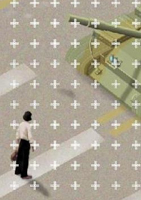
Art in the Age of Videogames
GameScenes: Art in the Age of Videogames :: Edited by Matteo Bittanti and Domenico Quaranta, this volume provides a detailed overview of the emerging field of Game Art, examining the complex interaction and intersection of art and videogames. Text in English and Italian.
Video and computer game technologies have opened up new possibilities for artistic creation, distribution, and appreciation. In addition to projects that might conventionally be described as Internet Art, Digital Art or New Media Art, there is now a wide spectrum of work by practitioners that crosses the boundaries between various disciplines and practices. The common denominator is that all these practitioners use digital games as their tools or source of inspiration to make art. They are called Game Artists.
GameScenes. Art in the Age of Videogames explores the rapidly expanding world of Game Art in the works of over 30 international artists. Included are several milestones in this field, as well as some lesser known works. In addition to the editors' critical texts, the book contains contributions from a variety of international scholars that illustrate, explain, and contextualize the various artifacts.
Posted by jo at 11:49 AM | Comments (0)
Superfactory(TM)
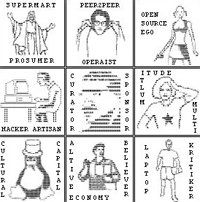
ASCII MEMEX Game "Be A Winner!"
A Memex Wall by Superfactory(TM) in a cooperation with mi_ga :: Rapid flow of letters and numbers on a monitor wall has nothing to do with chaos theory which can cause big disruptions in our world. It has also nothing to do with hackers world as one would like to say. Thus we show the monitor wall within a context of "memex game" a "memory extender" game, the term of which was used to call a proto-hypertext computer system influencing the development of subsequential hypertext and intellectual augmenting computer systems.
A "memex game" is a visual translation of that complex systems proposed by Vannevar Bush back in 1945. Here you get to know exciting people of the scene - the hacker artisan, the peer-to-peer oparist, the open source ego, etc. - all necessary to build up a more or less complex structure of contemporary economy and politics. The monitor wall or a Bookshelf how originally was called, represents a network traffic translated into descriptive form, so the unseen side of "networking" would be understandable or at least readable. In a technical terms the flow of letters and numbers on the monitors would sound like 'tcpdump', a common computer network debugging tool.
In the game you have to find certain motives with as few clicks as possible and as quick as possible. With click on 'neues Spiel' (new game) for a short time nine pictures are shown, whose situation must be reminded! You start the game with 100 points, each second is started one point is taken and each wrong click costs 3 points. Score as much points as possible and be a winner! Much fun and success!
Posted by jo at 11:43 AM | Comments (0)
June 08, 2007
Plundr

Piracy on the High Seas of NY
Plundr is a location-based game of piracy and trading on the high seas created by area/code. Start out as a bilge-spewing land-lubber in a leaky tub, search the ocean for unsuspecting ships to pillage, upgrade your ship, and amass a fortune in black market goods.
Plundr is designed to be played on laptop computers by players who are navigating through real-world space. The gameplay takes place on Islands where you can buy and sell goods, prey on Merchant Ships, and battle other nearby players. Each Island corresponds to a real-world location. [via]
Posted by jo at 11:30 AM | Comments (0)
June 06, 2007
De Pong Game
De Pong Game is a recycling of the famous game PONG [Atari 1975-1977]. This new version has been built with Flash [Action Script] by Arjan Westerdiep for Recyclism™ (Benjamin Gaulon).
This project is exploring the concept of Augmented Reality by using and interacting with urban architectures [buildings] as background for the game. Thus the game is projected on a building and the limits of that building are becoming the limits of the game area. The ball projected on the building bounces along the limits of the walls. The software is also using the windows as an obstacles for the game. So the ball is limited to frame of the building. As you touch the ball with the slider, its speed increases and because the ball bounces on all the obstacles of the architecture it becomes more and more difficult to play.
Posted by jo at 11:56 AM | Comments (0)
May 10, 2007
Wafaa Bilal: Domestic Tension
Iraqi born artist Wafaa Bilal has become known for provocative interactive video installations. Many of Bilal's projects over the past few years have addressed the dichotomy of the virtual vs. the real.
He attempts to keep in mind the relationship of the viewer to the artwork, with one of his main objectives transforming the normally passive experience of viewing art into an active participation. In Domestic Tension, viewers can log onto the internet to contact, or shoot, Bilal with paintball guns.
Bilal’s objective is to raise awareness of virtual war and privacy, or lack thereof, in the digital age. During the course of the exhibition, Bilal will confine himself to the gallery space. During the installation, people will have 24-hour virtual access to the space via the Internet. They will have the ability to watch Bilal and interact with him through a live web-cam and chat room. Should they choose to do so, viewers will also have the option to shoot Bilal with a paintball gun, transforming the virtual experience into a very physical one.
Bilal’s self imposed confinement is designed to raise awareness about the life of the Iraqi people and the home confinement they face due to the both the violent and the virtual war they face on a daily basis. This sensational approach to the war is meant to engage people who may not be willing to engage in political dialogue through conventional means. Domestic Tension will depict the suffering of war not through human displays of dramatic emotion, but through engaging people in the sort of playful interactive-video game with which they are familiar.
For the duration of May, 2007, Iraqi born artist Wafaa Bilal will live in the FlatFile Galleries in Chicago. The public can watch him 24 hours a day over a live webcam; and if they choose, visitors to his website can shoot him with a remote controlled paintball gun.
Bilal’s self imposed confinement is designed to raise awareness about the life of the Iraqi people and the home confinement they face due to the both the violent and the virtual war they face on a daily basis.
You can participate - eg shoot at him with a paintball gun - by clicking here.
See this site for some videos and more about the Wafaa's work. [via selectparks]
Posted by jo at 03:29 PM | Comments (0)
May 01, 2007
donaufestival 07
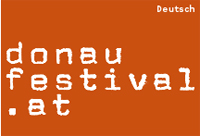
UNPROTECTED GAME S
"[...] Under the motto “unprotected games“, the donaufestival 07 atttempts – without claims to a kitsch utopia of change – to confuse the inner and outer view of (social) game systems with unprotected, artistic games, to swap positions on the thin red line between virtuality and reality and to simulate a risky match of reevaluation and anarchic freedom. Whether performance, media art, art game or musical statement: the donaufestival transforms, in a not unusual though induced form, into a platform for pop-iconoclasts, scrupulous poachers in Bambiland, whether as protagnist or voyeur or both, in personal union. So: make your unprotected game!" Tomas Zierhofer-Kin.
Artists A-Z
//////////fur//// art entertainment interfaces
Addictive TV
Artificiel (Julien Roy & Alexandre Burton)
Baby Dee
Biederman, Andrew
Big Art Group
Blast Theory
Bonnie Prince Billy
Boredoms
Burton, Alexandre (Artificiel)
Clauss, Julien
Current 93
Cyclobe
Deerhoof
ersatzverkehr
eSeL
ESG
Fennesz
Fiasco, Pablo
Finn, Simon
Forrest, Jason
Gang Of Four
Gob Squad
God's Entertainment
Gonzales
Haswell
Haswell & Hecker
Hecker
Hex, Fovea
Jóhannson, Jóhann
Justice Yeldham
Kent, Julia
Kids On TV
Killed By 9Volt Batteries
Koolwijk, Bas van
Krahl Theater, Von
Kreisky
KTL
Kubin, Felix
Kurokawa, Ryoichi
Kurzmann, Christoph
Larsen
Larsen featuring Jóhann Jóhannson
Lesser, Jay
Lidell, Jamie
Little Annie with Paul Wallfish
Lorbeer, Johan
Matmos
Matmos feat. Jay Lesser
Mocky
Niblock, Phill
Notwist, The
Nurse With Wound
Om
Pantaleimon
Parenthetical Girls
Patrick Wolf
plan b
Pook, Lynn
Poss, Robert
Priestbird
Prins, Gert-Jan
Ray_XXXX
rechenzentrum
Roy Julien (Artificiel)
Sand
Schnee & Sand
Schnee (Burkhard Stangl und Christoph Kurzmann)
Sawai, Taeji
Showcase Beat Le Mot
Six Organs Of Admittance
Sphären Versammlung
Stangl, Burkhard
Stenger, Susan
Sun O)))
Thibault, Alain
Throbbing Gristle
Tibet, David
toxic dreams
Two Fish
Vega, Alan
Yeldham, Justice
zeitkratzer volksmusik
zeitkratzer unprotected plays/unprotected music
Zeni Geva
Posted by jo at 06:30 PM | Comments (0)
April 27, 2007
THE RENDERED ARENA:
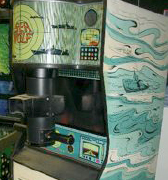
Modalities of Space in Video and Computer Games
"Abstract: During the last 30 years computer and videogames have grown into a large entertainment industry of economical as well as cultural and social importance. As a distinctive field of academic inquiry begins to evolve in the form of game studies, the majority of approaches can be identified as emerging either from a background of literary theory which motivates a concentration on narrative structures or from a dedicated focus on the rules in video and computer games. However, one of the most evident properties of those games is their shared participation in a variety of spatial illusions. Although most researchers share the view that issues related to mediated space are among the most significant factors characterising the new medium, as of yet, no coherent conceptual exploration of space and spatial representation in video and computer games has been undertaken.
This thesis focuses on the novel spatial paradigms emerging from computer and video games. It aims to develop an original theoretical framework that takes the hybrid nature of the medium into account. The goal of this work is to extend the present range of methodologies directed towards the analysis of digital games. In order to reveal the roots of the spatial apparatus at work an overview of the most significant conceptions of space in western thought is given. Henri Lefebvre’s reading of space as a triad of perceived, conceived and lived space is adopted. This serves to account for the multifaceted nature of the subject, enables the integration of divergent spatial conceptions as part of a coherent framework, and highlights the importance of experiential notions of spatiality. Starting from Michel Foucault’s notion of the heterotopia, game-space is posited as the dynamic interplay between different spatial modalities. As constitutive elements of the dynamic spatial system mobilized by digital games the following modalities are advanced: the physical space of the player, the space emerging from the narrative, the rules, the audiovisual representation and the kinaesthetic link between player and game. These different modalities are examined in detail in the light of a selected range of exemplary games. Based on a discussion of film theory in this context an original model that serves to distinguish between different visual representational strategies is presented. A chapter is dedicated to the analysis of the crucial and often overlooked role of sound for the generation of spatial illusions. It is argued that sound has to be regarded as the privileged element that enables the active use of representational space in three dimensions. Finally the proposed model is mobilised to explore how the work of contemporary artists relates to the spatial paradigms set forth by digital games. The critical dimension of artistic work in this context is outlined. The thesis concludes with a discussion of the impact of the prevalent modes of spatial practice in computer and video games on wider areas of everyday life." From THE RENDERED ARENA: Modalities of Space in Video and Computer Games by Axel Stockburger, 2006. [via selectparks]
Posted by jo at 05:57 PM | Comments (0)
April 18, 2007
AreYouHere?
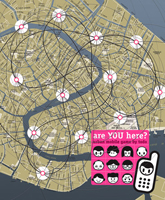
Venice - Urban Mobile Game
AreYouHere? :: 2007 - June 6th/15th - Venice - urban mobile game :: AreYouHere? is one of the 12 urban interventions of Migration Addicts, 52nd International Art Exhibition, La Biennale di Venezia, Collateral events :: Site: the whole city - starting point at Chiostro Ex Chiesa Santi Cosma e Damiano, Giudecca, 620.
AreYouHere? is an urban mobile game that aims to explore Venice through its inhabitants/migrants. More and more Venetians are leaving the lagoon to settle in other towns. In the next 30-40 years, it is certain that Venice's population will be dramatically reduced. Bar and hotel owners now come from abroad while the town is losing its original inhabitants and becoming more and more globalized. Thousands of tourists arrive to Venice everyday. The Observer provocatively wrote that if the only destiny of the town is low cost tourism then it would be better to have Venice managed by Disneyland Corporation. A kind of paradox is happening. Venice could be everywhere, that "exotic" does not exist anymore. Labor migrants from Asia are welcoming you and serving you Italian food. You are in Venice. But are you really in Venice? What do you see? Who do you meet?
AreYouHere? is an urban exploration through the faces of the people anyone can meet during his/her stay. Faces of migrants that have become the actual inhabitants, while the player is the stranger. A touristic and personal exploration of people and their faces. Those photos will be joined together into a personal postcard. He/she will receive the postcard at home. A postcard that is actually sent by him/herself. The player will receive the postcard to his/her home: a postcard that is actually sent by him/herself.. But the places you are supposed to visit, however, are not the ones you would expect to go, the top visited.
Surely you'd never take a photo of people who lives and works in these places. But that's what you have to do: shoot photos at immigrant people who live and work in Venice, carefully following the path that has been created for you, because you are the stranger, the tourist, and they are a part of Venice instead. You should take those photos with your mobile phone and send them by MMS to the number you found on the invitation. But remember, the first photo you send must be a photo of yourself: because you are a part of the game. [via]
Posted by jo at 04:34 PM | Comments (0)
April 13, 2007
spring_alpha
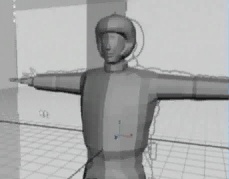
Rewritable on both the Narrative and Code Level
spring_alpha is a networked game system set in an industrialised council estate whose inhabitants are attempting to create their own autonomous society in contrast to that of the regime in which they live. The game serves as a "sketch pad" for testing out alternative forms of social practice at both the "narrative" level, in terms of the game story, and at a "code" level, as players are able to re-write the code that runs the simulated world ... 'spring_alpha' is a game in permanent alpha state, always open to revision and re-versioning. Re-writing spring_alpha is not only an option available to coders however. Much of the focus of the project lies in using game development itself as a vehicle for social enquiry and speculation; the issues involved in re-designing the game draw parallels with those involved in re-thinking social structures. [via]
Posted by jo at 07:15 PM | Comments (0)
April 05, 2007
Coverage of Gameworld at Laboral
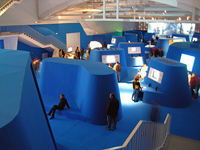
You'd be right to think Gijon, Spain might seem like an unlikely place to host the largest exhibition on the field of artistic games to date. This didn't stop thousands from attending, many who flew in for the show. The great turnout was of course also due to the fact that Gameworld was just one of four concurrent exhibitions inaugurating the opening of the Laboral, the gigantic new Asturian art center (North of Spain).
I arrived on Tuesday after spending a few sleepless nights working on my own piece for the exhibit, a 2 player version of my Second Person Shooter in the form of a QuakeIII mod. I had no idea quite what to expect, though I'd helped out curators Carl Goodman and Daphne Dragona a little with advice on what shape the show should've taken. I walked into an enormous interior partly-clad blue landscape, a lot of hardware, whirring drills and a few dozen people looking quite confused about it all. This is what it looked like less than 36 hours before the opening (thanks to Feizi for the snap). More >> [blogged by Julian on Selectparks]
Posted by jo at 07:04 PM | Comments (0)
Roy Block: A platform game with real platforms
Experimental gaming these days is all about playing with reality. From virtual reality and alternate reality to augmented reality, more and more people are trying to merge video games and real life in interesting ways. Sebastien Schmieg's art project/game Roy Block adds another term to this growing list: mixed reality.
Roy Block uses real life, handheld wooden building blocks as the platforms for an on-screen avatar. A hidden camera detects the blocks as they're pressed against the tracing paper projection screen, translating their position and alignment to in-game data.
The "gameplay" in the project is pretty basic -- just guide the periodically jumping Roy from one end of the screen to the other while avoiding floating enemies -- but Schmieg sees the potential for more complex play by assigning different functions to each side of the blocks. Schmieg also has an idea for a version "as big as a wall ... with blocks so big that you need both hands to hold one." Would that be mixed reality exergaming? More buzzwords, stat! [Posted by Kyle Orland on Joystiq]
Posted by jo at 11:29 AM | Comments (0)
April 04, 2007
Day Of The Figurines at Lighthouse, Brighton
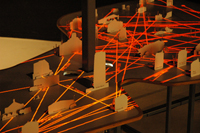
UK Premiere
Blast Theory presents the world premiere of Day Of The Figurines, a mass participation artwork using mobile phones that is part board game and part secret society. Set in a fictional English town that is littered, dark and underpinned with steady decay, the game unfolds over 24 days, each day representing an hour in the life of the town. Up to 1000 players place their plastic figurines onto the board. They are moved by hand in a meticulous performance throughout the duration of the exhibition.
Players participate by sending text messages. They must help other players as they receive updates from the town, missions and dilemmas. They can also chat to players who are near them in the town using text messages as events unfold in the town: a gig by Scandinavian death metallists, an invasion by an Arabic army, a summer fete. Day Of The Figurines is the world’s first MUD (Multi User Domain) for mobile phones.
Opening times
4th to 27th April 12 – 4pm
Venue: Lighthouse, 28 Kensington Street, Brighton, BN1 4AJ
Day Of The Figurines was developed by Blast Theory in collaboration with the Mixed Reality Lab at The University of Nottingham, Sony Net Services and The Fraunhofer Institute as part of the European research project IPerG (Integrated Project on Pervasive Gaming).
Additional tour Dates
Day Of The Figurines, Fierce! Festival, Birmingham, 18th May to 10th June
Can You See Me Now?, Donau Festival, Krems, Austria, 19th to 21st April
Can You See Me Now?, Dublin, 9th to 12th May
Can You See Me Now? won the Golden Nica for Interactive Art at Prix Ars Electronica and was nominated for a BAFTA Award.
Posted by jo at 11:05 AM | Comments (0)
April 02, 2007
Judgement Day for 1st Life Game Figures
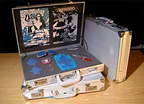
Tagged City Play for Real Players in Real Cities
The Ludic Society's Tagged City Play for Real Players in Real Cities was recently presented at Social Hacking, a series of temporary public art commissions for the city of Plymouth (UK).
Attracted by the slogan Become a game figure by implant!, participants were invited to get an injection of “RFID Judgement tags” under the skin. They then become Real Players, 1st life personae who are also game figures in the Reality Engine while playing in a real city. They can drive tuned Plymouth racing cars to tag the city and receive a tagging toolbox containing graffiti, spray stencils, stickers, RFID stickers and implant injection kits.
Real objects in the city are subjectively chosen for tagging. The tags are functional but useless (RFID-tags with zero data.) By putting this zero-tag on an object, players de-valuate real world things into virtual play-objects. If the Real Players find a tagged object with a value assigned to it, they zap it. The goal is to change the value of tags into the value Zero by using their “Wunderbäumchen” (inspired by the car air fresheners in the shape of a pine), technical toys used for finding and reading tags and/or emitting a target-oriented electro magnetic pulse..." Continue reading >> [blogged by Regine on we-make-moeny-not-art]
Posted by jo at 11:30 AM | Comments (0)
March 25, 2007
NOEMA

Ideas + Survey
Generic Infrastructures [2] by Rob van Kranenburg: Today we are in the worst situation imaginable. Our global and undisputed computing paradigm posits that computing processes are successful only in as much as they disappear from view. Our design focus is ever more following Philips untenable but seductive ‘sense and simplicity’ resulting in the-bug-as-a-feature-design of the Ipod Shuffle. Our educational system is following this systemic hide-complexity strategy that favors the large industrial labs, IT conglomerates and above all their clinging to notions of IP and the patent that are firmy tied to their notions of doing business and making money. And our users, us? We are YOU, the most influential person of the year 2006, according to TIME Magazine. You fill the Wikipedia entries in your spare time, you blog your daily activities, you co-bookmark on de.l.i.c.i.o.u.s, upload your photos to flickr, you buy mating gear in Second Life, and mark your position on Plazer or Google Earth. You fill out the forms. Isn’t it time you start questioning the principles behind the formats? And, to make matters even worse, your naïve ideas of sharing are corrupting notions of privacy, transparency and informational architecture symmetry.

Ludium II - Synthetic Worlds and Public Policy by Edward Castronova: Synthetic worlds – million-player online environments with genuine markets, societies, and cultures – are exploding in size and significance. Real world governments around the globe are beginning to grapple with their implications in the areas of taxation, intellectual property laws, consumer rights, addiction, violence, and more. Should synthetic worlds be controlled by developers, or by governments, or both? What about the rights of users? What general norms should legislatures and courts follow? More NOEMA >>
Posted by jo at 01:33 PM | Comments (0)
March 23, 2007
pay attention to the dance

Storytelling on the Web
Sean Stewart and Elan Lee, creators of two of the most successful alternate reality games to date, gave the keynote speech at this year's Arg-Fest-O-Con, a conference of the alternate reality gaming community. The whole video is over an hour, but well worth a look; the theme of the speech is 'trust'.
When I wrote a little while ago about ARGs as an emergent genre of storytelling entirely native to the Web, I identified some ways in which an ARG differs from the conventions of fiction in print form. In particular, part of the pleasure of an ARG is that it blurs the line between fact and fiction. There is a strange thrill to not knowing whether the latest link in the trail is fact (out of game) or fiction (in-game). It is also participatory and collaborative: the story does not unfold unless readers (players) collaborate to follow the trail of puzzles, hidden clues and hints. And though the story itself is 'authored' – the sites are prepared ahead of play, the story is worked out, and the whole operation is meticulously planned – it is always in a sense improvisatory. If the players pick up on a mistake, the 'puppetmasters' (game creators and operators) will work as fast as they can to incorporate it into the story if possible, so as not to destroy the fabric of the game.
Stewart and Lee describe the process of unfolding an ARG as a dance between players and puppetmasters, in which players are invited to suspend their disbelief for the duration of the story. Within the invitation, they explain, is a promise that you won't be made to feel stupid for playing along. And behind all this is trust on both sides.
This is important, he says, because no-one really knows how this genre works. Printed books bring with them a whole host of familiar protocols around how you read. People are familiar with the physical conventions of a book and the formal conventions of particular genres of book, and hence the experience is codified in a way that allows for a degree of detachment between producer and consumer. In contrast, ARGs as a genre are (in their current form, at least) less than ten years old and have very few established generic or formal codes. So in lieu of a tradition, the genre needs trust between participants.
It's also important because in an ARG suspension of disbelief works very differently. Whereas I know my novel stops being 'real' when I put my book down, an ARG inserts itself into my life in a much less clear-cut way. The game might phone you up, email you, post things to your house; all these events would be part of the story. Unlike a novel, it does not have edges. This lack of edges is typical of the Web. A blog is never finished, there is always a new link, and so on. But for fiction, this poses problems: if I'm suspending disbelief so I can enjoy the story, I want to know that I'm not going to be made to feel stupid for going along with it. I also need to know at what point to snap out of it and start taking things literally again. So it is no surprise that two prominent exponents of a kind of storytelling with no formal boundary-markers (no proscenium arch, if you will) emphasise the importance of trust between creators and participants in such a story.

The late Susan Sontag's recent piece in the Guardian is a passionate plea for the cultural and moral importance of novels. Narratives, she says, are of vital importance in helping humans make sense of their reality. I am one hundred per cent with her on this. However, she confines this faith in the improving power of stories specifically to the novel, while managing to sidestep both the cultural specificity of novels as a form, and role of oral storytellers, court poets, bards, folk tales and the countless other narrative traditions throughout history.
In the course of her rallying-cry for the novel (also, incidentally, a phillippic against those claiming the book to be dead), she inveighs against television (which rant I rather liked), and also proposes 'the hypernovel' as her main example of why fiction on the Net will never work. This 'hypernovel' as she describes it, is characteristically multiple-choice, notionally endless, possibly multi-authored and directionless narrative with none of the salutary benefits of stories that have a beginning, a middle and an end. And this, she implies, will simply not do. Readers like stories.
Given the ahistoricity of her approach to stories in general, it seems likely to me that Sontag takes for granted the established model of print authorship. This by necessity assumes a writer radically severed from its readership - which, as it is a paper book, cannot join the conversation - by a complex and time-consuming book-production process. The way she discusses debates around 'the hypernovel' clearly assume an equivalent level of detachment between the this notional hypernovel's creator and its consumers. But the model of separation between author and readers simply does not work on the Web, a medium characterised by minimal publication lead time and a conversational dynamic. However, this does not mean that, on the Web, storytelling is impossible. Nor does it mean that that nothing is ever authored. It just means it works differently.
The Web is a young medium. And ARGs are - by its enthusiasts' own admission - a very new genre. I would be very surprised if it did not evolve much further. But I'd be interested to know what Sontag might have made of a genre of storytelling that used not print but the Web; and yet, was not directionless or multiple-choice but collaboratively played out; that was authored, but with room for improvisation; and that took as its founding principle a delicate consensual suspension of disbelief rooted not in clear boundaries between 'fact' (the world outside the book) and 'fiction' (the world inside it) but in trust between all participants in the story. [posted by Mary Sebastian on if:book]
Posted by jo at 05:20 PM | Comments (0)
March 13, 2007
Erasing the delta:

Games that alter reality!
Here are my notes for my first Game Developers Conference talk, as part of a serious games summit panel on “Erasing the Delta - Games that Accomplish a Specific Task” The theme of the panel is about moving away from games that just prepare you to do something (learning/training games), or help you think about something (simulation games, persuasive games) and games that actually enable and indeed require you to do that thing, or to produce that thing, simply by playing them (games that work).
(Fellow ARG travelers Brian Clark and Brooke Thompson were there -- yay! we are so totally going to alter reality through play...)
(UPDATE: There's nothing that makes me post-talk happier than when multiple different communities take away ideas they're excited by. So I'm happy to see, for instance, some great responses to the talk at MTV, ARGN, and Destructoid!)
My spiel follows:
Erasing the Delta Gap is really about two different practices:
Making a new kind of serious game: Games that are designed as functions with an end result that is a measurable difference in the present state of reality. Serious games now are viewed as “resources” (for education, training, instruction, simulation) or “platforms” (for messages, persuasion). We must start to create serious games as “generative processes” or “solutions to problems”
Redefining what we define as a “serious impact”: We must move away from “preparation” and “knowledge” and “skills” and “rhetorical effect” as our only serious impacts. We can also consider for example “improved quality of life” and “better health” and “improved social organization” and “future resources produced”. In these terms, many games are already closing the delta gap, particularly in the area of health -- if we think of something like “reducing human suffering” as a serious impact (games for pre-surgery sedation) or intervening into the obesity epidemic (physical activity games) or, in the future, things like serving as a live suicide prevention resource (instead of calling 1 800 suicide) or facilitating global security through youth cooperation and co-immersion. So: What is the role of Alternate Reality Games in erasing the delta?
The new opportunities for ARGs to do work is best understood as a movement through different definitions of “realism” in gameplay
Realism in ARGs
1st wave ARGs: they’re so real! Real Life (embedded in real, working life): operational, everyday technologies, intimate
2nd wave ARGs: they’re so real! Real World (moving into real-world spaces): social, physical, face to face, everyday spaces, public
3rd wave ARGs: they’re so real! Real Impact (starting to solve real-world problems, for example: global relations/world peace, massively multiplayer science, quality of life, learning): intentional, effective. Games that alter reality!
Two factors that make this third wave possible:
Our culture is becoming more ARGlike (CI culture, participatory Web culture / 2.0, creative commons, science commons)
Our culture WANTS to be more ARGlike (the spirit of massive collaboration saving the world)
Examples of ARGs that start to erase the delta:
Past - Tombstone Hold ‘Em – putting live bodies back in cemeteries, creating a public culture for a dying public space
Present - World Without Oil – generating a massively collaborative map of potential, citizen responses to oil shock; constructing a database of lower-consumption practices that might prevent that shock from happening
Future - Massively Multiplayer Science – games with real scientific data embedded in them, and gameplay to collect, analyze and process the data in massive parallel.
[blogged by Jane McGonigal on Avant Game]
Posted by jo at 01:47 PM | Comments (0)
March 06, 2007
Word Finder, Google Earth Edition
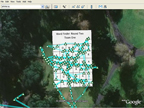
1st Life / 2nd Life Game
Julian Bleecker writes: This is a 1st Life / 2nd Life game that is based on paper-based word-finder games. In this game, you try to identify dictionary words within a grid of letters and circle them. In this variation, the landscape becomes the game grid and you have to walk (or run!) to generate a virtual line that runs through the letters in order to "capture" the word and score points. A GPS is used to help the team identify where the letters are in 1st Life space, and to "capture" the words composed of those letters by recording "track logs" through them. The GPS is able to record where you are in 1st Life, and to create "tracks" of locations, which are essentially connected points that make up lines on the GPS. These track logs can be seen as a way of geospatial drawing — the tracks you make delineate lines which can compose various forms of drawing. In our case, the lines are meant to create lines through the letters that make up the words. (Note that in the more traditional word finder games one circles the letters — that would be a bit tricky in this variation, so we'll just draw an approximate line _through_ the letters. Continue reading >>
Posted by jo at 05:03 PM | Comments (0)
February 28, 2007
Erik Nelson + Doo Yul Park

Sonorous + Sonanos
Abstract: Sonorous is an experiment in game design which aims to explore the possibilities of using music and sound as an alternative to traditional story-like narrative as the primary means of creating context for gameplay, and facilitating player engagement. Sonorous takes the form of a shortened Real Time Strategy game, where each unit the player controls takes on the properties of a musical instrument in the player's own temporary musical ensemble group. Through player choices and actions, the units will dynamically create and alter the musical score. The primary experiential goal of the piece is to evoke a grooving, or joyful dancing reaction in the player. The primary research goal of the project is to identify several tenets of Interactive Sound Design as they relate to games, in the hope of unveiling new game mechanics and systems which could be applied to arcade style and casual video games.
Keywords: Sonorous, Interactive Music, Musical RTS, Game Audio Synchronization, Game Event Synchronization, Music/Narrative, Interactive Sound Design, Grooving RTS
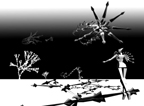
SONANOS: A Musically Structured World
Abstract: SONANOS is an application for interactive visual music. In this PC software, the user simultaneously composes music and constructs objects in a 3D environment. Combining objects generates rhythms, melodies, and phrases, which are determined by the visual properties of the procedurally generated objects. In the virtual environment, users can manipulate both the visual and musical structures. As a result, the user character evolves. The user character transforms, which represents the development of the composition. SONANOS adheres to the aesthetic conventions of the visual music genre, in which abstract graphics correspond to the rhythm. In this project, interactivity amplifies the synesthetic experience by enabling self-expression and deepening the connection between graphics and music.
KEYWORDS: SONANOS, synesthesia, interactive visual music, music video game, art game, procedural/generative/algorithmic graphics/ music/animation, music creation/composition game, musically structured world.
Posted by jo at 04:00 PM | Comments (0)
February 23, 2007
Experimental Gameplay: Toward a Massively Popular Scientific Practice
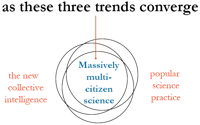
Massively multi-citizen science is almost here
Can a game developer be nominated for a Nobel Prize in one of the sciences by the year 2032? That's my plan, which I presented this past weekend at the annual meeting of the American Association for the Advancement of Science. You can download the slides from my talk, or read the related research paper (hot off the press!), or peruse some related links, on my AAAS webpage here. (Or see what Newsday took away from it here.)
My goal over the next decade is to support the development of a massively multi-citizen science through massively collaborative games (think: alternate reality games with real-world data embedded inside.) So in the near future, when the most creative, collective-intelligence gamers are grinding away 10, 20, 30, or more hours a week, they're grinding on real scientific research problems wrapped inside a yummy fictive or fantasy shell.
Yes, I am calling for a truly popular scientific research practice that engages the global public in hands-on, brains-on collaboration, via sites Citizen Science and Amazon's Mechanical Turk and through immersive, story-driven play. Amateur participation + a creative commons for science literature + the stickiness of a well-designed game and well-told story = radically interdisciplinary mash-ups accessible to lay people and productive of real scientific insight.
Sound crazy? No way. This is seriously possible, and plausible. Here's three reasons why:
1) Science practice itself is increasingly leaning toward a kind of collective intelligence, amateur participation. You can read about it in the incredible Institute for the Future report: Delta Scan: The Future of Science and Technology, 2005-2055.
2) Meanwhile, there is no doubt -- as I argue in my new 50-page case study for the MacArthur foundation -- that alternate reality gamers are doing real CI investigations that would fully prepare them for real-world collaborative research. Their gameplay is already fundamentally a CI scientific effort to undertand fake (fictive) data. I'm just proposing that we shove some real scientific data in there, while they're at it.
3) And perhaps most importantly, as Sean Stewart - the original and most esteemed alternate reality storyteller around - has famously said: "I do NOT assert that [alternate reality gaming] is the first, or greatest, example of massively multi-player collaborative investigation and problem solving. Science, as a social activity promoted by the Royal Society of Newton's day and persisting to this moment, has a long head start and a damn fine track record.... We just accidentally re-invented Science as pop culture entertainment."
So, yes, If this sounds interesting, get the slides. And here are a couple of other sites to get you thinking: "Fostering Scientific Habits of Mind in the Context of Online Play" and MacArthur Spotlight on Digital Media & Learning.
If you want to propose a data set, scientific problem, or research focus for a massively multi-citizen science game, or if you want to be notified when there's such a game to be played, email me at jane @ thenameofthisblog dot com. [bblogged by Jane on Avant Game]
Posted by jo at 06:00 PM | Comments (0)
January 24, 2007
Viroid Flophouse

An Exploration of Playable Art
The Viroid Flophouse was an exploration of playable art in an online gaming environment, which incorporated movement, motion tracking, streaming technologies and telematic performance, within the common theme of "virus."
It was a hybrid game/performance environment created by ADaPT (Association for Dance and Performance Telematics) which includes among others Arizona State University (Tempe, Arizona), Nottingham Trent University (Nottingham, UK), Wayne State University (Detroit, Michigan) and Waag Society for Old and New Media (Amsterdam, NL).
The sites functioned as rooms in the "flophouse," in which on-site participants could interact with remote participants.
The ADaPT members involved in this production included a team from Arizona State, spearheaded by John Mitchell, a small team from Waag Society headed by Josephine Dorado, with additional input from Johannes Birringer (Nottingham Trent University).
Previous renditions of the project:
ADaPT had already experimented with one rendition of the project, named the Saira Virous which involved teams from Nottingham Trent University, headed by Johannes Birringer, and Wayne State University, headed by Kelly Gottesman.
Birringer's documentation of the Saira Virous can be viewed at the following urls:
http://art.ntu.ac.uk/performance_research/birringer/lat5.htm
http://art.ntu.ac.uk/performance_research/birringer/lat.htm
http://art.ntu.ac.uk/performance_research/birringer/lat4.htm
That rendition of the project mainly focused on the extension of dance performance telematically within an online gaming infrastructure, via streaming and projected media integrated with live performance.
The introduction of OSC (Open Sound Control protocol) into the gaming structure: In our rendition of the project, the goal was to enhance the interaction by incorporating the sending and receiving of OSC data (Open Sound Control protocol) combined with motion capture, into the scenario.
The incorporation of osc data transmission over a network, in combination with motion capture via softVNS, enabled the sites to communicate the performers’ positions to each other. That data, in turn, could be used to control game events.
The gaming structure: The game structure was developed and was based on the action of the remote and local gamer "sharing" the same space. In other words, the gamer in Arizona and the gamer in Amsterdam had to position themselves in the same virtual gaming space in order to get to the next level. The game was played by Arizona and Amsterdam players in this fashion, with supplementary commentary being streamed in sports commentary style, from Birringer.
Posted by jo at 09:45 AM | Comments (0)
January 19, 2007
Second Person:
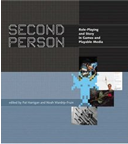
Role-Playing and Story in Games and Playable Media
After the enthusiastic response to First Person, many people suggested that we create a sequel — and we acted on that idea. Today Pat Harrigan and I are happy to announce the publication of a new edited volume: Second Person: Role-Playing and Story in Games and Playable Media (table of contents, Booksense link, ISBN.nu link).
Like First Person, Second Person takes an unusually broad look at our field — and, in order to do so, discusses topics rarely given their due in previous scholarly publications. These range from tabletop role-playing games to improvisational theater, from political games to procedural authorship. The approach is to begin with specifics, and from there build up the insights of game designers, artists, writers, computer scientists, and scholars.
I’m sure I’ll be writing more about Second Person in the future. But now, for those interested, I’ll include the book’s introduction below.
How should we explain to someone what a game is?
I imagine that we should describe games to him, and we might add: “This and similar things are called ‘games.’” And do we know any more about it ourselves? Is it only other people whom we cannot tell exactly what a game is?
But this is not ignorance. We do not know the boundaries because none have been drawn.
– Ludwig Wittgenstein, Philosophical Investigations, aph. 69.
In fact, perhaps too many boundaries have been drawn. There are quite a few attempts to erect borders around the concept of game — especially now that games are increasingly recognized as a major cultural force, and as game studies emerges as an academic discipline.
However, in this volume the contributors are not interested in questions such as “What is a game?” This book is not concerned with questions of center and periphery. Rather, we are interested in questions such as “How is this played?”
For this reason we have adopted the term “playable media” to point toward our overarching concern. This includes games, as well as other forms that “invite and structure play” (Wardrip-Fruin 2005). This volume’s contributors discuss role-playing games, board games, card games, computer games, interactive fictions, political simulations, improvisational theater, massively multiplayer games, locative media, live action role-playing, and more.
Of course, there are a variety of potential topics that one could pursue in relation to these forms. Second Person focuses on two interrelated strands: role-playing and story. These concepts run throughout this book, sometimes in parallel, sometimes in tension with each other. There is not always a happy marriage between something played and something told. If you are an actor in King Lear, Shakespeare has provided you with both a coherent story and a role to play within it — but your freedom of movement within your role is limited by the text. You may hiss or shout or whisper your lines; the director may choose to set the play on a Martian colony and portray Lear as a intelligent shape-changing fungus — but in the end, unless you are Thomas Bowdler, you will say, “My poor fool is dead,” and sink into the fullness of the tragedy.
Conversely, as children you may have played “Cops and Robbers,” or “Cowboys and Indians” (the examples of choice for a generation of tabletop role-playing game Introduction writers). In this case there is nothing to constrain what you say, where you run, who you shoot — but there is also no structure to speak of, nothing to ensure that the person you shoot falls down, that the villains wind up in jail. (This is what Rebecca Borgstrom calls the “nuh unh” factor.) The end of this sort of play, if it can even be said to have an end, is not the ending of a coherent fiction. The events here are arbitrary and contingent, and therefore the opposite of what we call “story.” Beyond this there is the question of how the structures of story differ from one medium to another; telling a story in a novel is not the same as enacting it in a video game. Stories are experienced differently between the tabletop, the computer, and the stage. New forms of media not only require new approaches to story, but may even force us to re-examine our assumptions about how stories are told in more traditional forms.
By design, the subject of most of Second Person’s contributors is, centrally, “you.” This is because you are the person for whom the story is being told, and because the roles discussed in this book will, for the most part, be filled by you. Colossal Cave Adventure, the first computer text adventure, famously addresses the reader, “You are in a maze of twisty little passages, all alike.” The Cave of Time, the first Choose Your Own Adventure book, announces that, “The adventures you take are a result of your choice. You are responsible because you choose!”* Jeremy Douglass, in his essay here, points out that even the most “first person” of game experiences — the 3D virtual reality that reaches its apotheosis in room-sized CAVE displays — serves the same function as the textual second person: simulated immediacy.**
Outside these caves, tabletop role-playing games speak directly to you as well; to pick only one example, Jonathan Tweet’s Over the Edge tells us:
This game is a coded message. You will decode the message in your dreams and execute its instructions in the spaces between moments of will. Neither you nor I will ever know the contents of the message. (Over the Edge 1997, 2)
The authors, artists, and theoreticians in Second Person address the exigencies of playable media in a number of ways, and in a number of voices. Some essays are informal in tone, some academic, and some highly technical; this polyglot speaks to the varied disciplines from which our contributors are drawn.
For convenience the editors have arranged the essays into three sections.
Section I groups together essays about fictions playable on your tabletop, or in your easy chair, without aid of nonhuman calculation. Many of these, such as the tabletop role-playing games (RPGs) under discussion, have an explicit social component. Some, like Kim Newman’s Life’s Lottery and Eric Zimmerman’s Life in the Garden, can be seen as variations on traditional author-reader expectations.
Section II is concerned with computer-based playable structures. Here are Nick Montfort’s and Jeremy Douglass’s thoughts on Interactive Fiction (IF) and Michael Mateas and Andrew Stern’s in-depth discussion of their interactive drama, Facade. Broadly speaking, the works discussed here are designed to be interacted with by one person: the singular, not plural, “you.”
In section III we return to the social spaces of section I, but in a wider variety of ways. Our contributors discuss the virtual communities of massively multiplayer online role-playing games (MMORPGs, or MMOs); we see how digital media (as well as older role-playing techniques) inform political discourse; and we enter into multiple other theaters as well.
In addition, we have reprinted as appendixes three fully playable tabletop RPGs. Two of these (Puppetland, The Adventures of Baron Munchausen) are discussed in essays in this book. The other (Bestial Acts) is also written by one of our contributors, and as it explicitly tries to import Bertolt Brecht’s theatrical concepts into a tabletop RPG format, it may prove somewhat more of a challenge to play, particularly for the faint of heart. These three RPGs provide not only an invitation to play, but demonstrate the wide variation possible in what many people still insist on seeing as a hidebound form.
Our hope is that this book will appeal to a wide variety of audiences. It discusses a number of playable forms, some of which have been unfortunately ignored by the academy, and all of which are important as we seek to understand our fields’ presents and futures. For example, in the last few years there has been much academic discussion of video games and other forms of digital media, but little that acknowledges in any depth the debt many of these forms owe to tabletop role-playing games. Further, it is not too much to say that where academic discussion of tabletop RPGs exists, it is largely cursory — and, not infrequently, wrong.***
At the same time, the hobby game industry (of which tabletop RPGs are a part) has not, as a rule, examined its output in any thorough critical or analytic way — the companies that release RPGs preferring to concentrate on selling product rather than philosophizing about it. There are some exceptions, of course, particularly among the growing indie RPG movement, which we will have more to say about in our introduction to section I.
Second Person does not pretend to provide an exhaustive critical overview of tabletop RPGs, or of any of the other forms that bring together gameplay, roleplay, and story. But we hope it provides a framework for further examination of these forms, by placing these works into a continuum of artistic production and providing a sampling of approaches to them driven by game design, creative writing, and more traditional scholarly frameworks. The next step, as we understand it, is up to you.
—
* The Choose Your Own Adventure series was an outgrowth of Edward Packard’s Adventures of You books.
** In the editors’ opinion, the best novel to engage the VR CAVE technology is Richard Powers’s Plowing the Dark, which makes heavy use of the second person form of address.
*** As an example, an excerpt from Allucquere Rosanne Stone’s The War of Desire and Technology:
The first RPG was published as a set of rules and character descriptions in 1972 and was called, appropriately enough, Dungeons and Dragons. It was an extension, really, of SCA into a textual world. D&D, as it quickly became known, used a set of rules invented by the Austin game designer Steve Jackson called the Generic Universal Role Playing System, or GURPS. (Stone 1995, 68)
While it might be quibbling to point out that Stone has D&D’s publication date wrong (see Erik Mona’s essay for an accurate account of this history), it is harder to overlook the fact that The War of Desire and Technology gets the relationship between D&D and GURPS exactly backwards. It was D&D that inspired GURPS (as it did every tabletop RPG), which appeared more than a decade afterward. [blogged by noah on Grand Text Auto]
Read Emily Short's Review.
Posted by jo at 06:22 PM | Comments (0)
Packet Garden
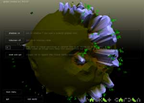
Landscapes of net behaviour
Packet Garden, developed by Julian Oliver, captures information about how you use the internet and uses it to grow a private world you can later explore.
The (free) software keeps track of all the servers you visit, their geographical location and the kinds of data you access. Uploads make hills and downloads valleys, their location determined by numbers taken from internet address itself. The size of each hill or valley is based on how much data is sent or received. Plants are also grown for each protocol detected by the software; if you visit a website, an 'HTTP plant' is grown. If you share some files via eMule, a 'Peer to Peer plant' is grown, and so on.
None of this information is made public or shared in any way, it's your own private landscape.
Somewhat related, Visualization of statistics in computergames, by Michael Zoellner and Daniel Kupczyk, tracks and projects the behaviour of German internet users in a 3D world. Topics as different as politics, sex, sports, environment or economy are translated into the appearance, behaviour, and the sounds of an avatar. As the stream of data creates and changes, so does the population of this world, unvealing a mirror image of the net society.
The game consists of three scenarios with different levels of interactivity and abstraction. The first level shows a landscape of islands, each island representing a subject area, coded by colours and textures connected to the topic. the avatars feel attracted by the topic islands to which they belong and stay close to them.
The second level gives the player more possibilities for interaction and to influence what is happening in the game.
The third level represents a realistic environment, a scene in the street with a supermarket, cars and lawns. This representation projects the statistics in a real world. in a later further development the game could be experienced in an augmented reality environment, meaning that the avatar would be projected in a real scenery.
Search words which date back further in the past are represented by ghost-avatars. One can recognize very fast how different weekdays and daytimes influence the search words and hereby the significance of the categories. On a Sunday morning you will find another population as during the nightly hours of a working day.
Via a comment by Bjoern, information aesthetics and selectpark + La petite Claudine. [blogged by Regine on we-make-money-not-art]
Posted by jo at 09:54 AM | Comments (0)
January 17, 2007
Book and Volume

Art Barter
I have 30 hand-labeled USB flash drives that contain my 2005 interactive fiction Book and Volume - they also contain a silly promotional video for Book and Volume and a press kit. These are material artifacts that store some of my free digital literary work. To be clear: you do not need one of these to play the game. Anyone can download Book and Volume for free. These USB drives are also not technological artifacts you’d want for their own sake. They hold only 32MB.
Nevertheless, would you like one of these? I will send one to anyone who sends me some material art object or creative document along with a return address. I don’t mind, of course, if the artwork you send is mass-produced - no “aura” is required. It could be, for instance, a book you wrote, a poem (written, printed, recorded), a print, a tape, CD, or DVD of yours, or some computer media with your work on it. You could send a bumper sticker you created, a Fluxus box, or documentation of one of your performances, installations, or exhibits.
If you’re interested, please mail your art barter goodie to the following address, and be sure to include your own address so I can send you a Book and Volume flash drive in return:
Nick Montfort
University of Pennsylvania, IRCS
3401 Walnut Street
Suite 400A
Philadelphia, PA 19104-6228
When I either run out of these or finish up at Penn and am no longer at this address, I’ll update this post. [posted by nick on Grand Text Auto]
Posted by jo at 03:42 PM | Comments (0)
January 16, 2007
Serious Games
![]()
Pax Warrior
Pax Warrior is a Hybrid New Media product for the educational and training markets that extends the nascent "Interactive Documentary" form to incorporate decision based simulation and collaborative learning tools. It is at the lead of the new genre of "Serious Games". Pax is an engaging way to learn about history, civics, citizenship, social studies and current events.
Pax Warrior: The Experience - our introductory module - weaves the tragic story of the UN experience in Rwanda placing the user, first person, in the shoes of a UN Commander trying to maintain peace. What are the terrible choices to be made? What would you have done in his shoes? What will you do to make sure this never happens again?
Posted by jo at 09:32 AM | Comments (0)
January 11, 2007
InSense: Interest-based life logging
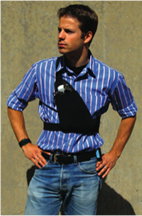
Mapping First Life Experiences with Virtual World Counterparts
Blum, M. Pentland, A. Troster, G. (2006), InSense: Interest-Based Life Logging, IEEE Multimedia, 13 (4), pp. 40- 48.
The paper describes a wearable data collection device called InSense based on Vannevar Bush’s Memex principles. allows users to continually collect their interactions as store them as a multimedia diary. It basically take into account the sensor readings from a camera, microphone, and accelerometers. The point is to “classify the users activities and “automatically collect multimedia clips when the user is in an “interesting” situation“.
What is interesting is the types of categories they picked-up to develop their context-aware framework: they chose location, speech, posture, and activities—to represent many diverse aspects of a user’s context. They also have subcategories (for instance for location: office, home, outdoors, indoors, restaurant, car, street, shop).
The experience sampling approach works like that:
Subjects wear the system for several hours without interacting with it. Audio and acceleration signals are recorded continuously. The camera takes pictures once a minute and WiFi access points are logged to establish location. After the recording session, the user employs an offline annotation tool, which presents an image at a time, the corresponding sound clip, and a list of labels from which to chooseshowing sensor placement.
What is also curious is their description of their algorithm that calculates the current level of interest of an event based on the context classification.
Why do I blog this? I am less interested in the purpose of the system itself (sharing material) but rather by the data extracted from context readings and how this could be used to tell a story (or to build up a narrative). Of course, given my interest in games, I see this device as intriguing and potentially relevant to map the first life experience with virtual worlds counterparts; it could go beyond current pedometer that control dogs. [blogged by Nicolas on pasta and vinegar]
Posted by jo at 02:34 PM | Comments (0)
January 07, 2007
5 Courts
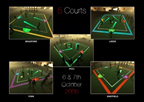
Played Across Five Cities
5 Courts is a revolutionary multi-player, multi-site game and arts space played across five cities: York, Leeds, Bradford and Sheffield in October 2006. Players use their own bodies to send balls of projected light across the playing space, aiming for goals representing the other cities. Entirely interactive, it's a competition to see which city has the least light balls in their square when the time runs out. Designed to be aesthetically beautiful and great fun to play and watch, games are a minute long and run throughout the night.
5 Courts was conceived, designed and programmed by digital media artists KMA (Kit Monkman & Tom Wexler). The piece was commissioned by Illuminate as part of the Light Night festival. [blogged by Martin Rieser on Mobile Audience]
Posted by jo at 05:47 PM | Comments (0)
December 26, 2006
netPong

Playing Pong walking with a laptop
"The tilting sensor embedded in some of the latest Apple laptops has induced many projects focused on experimenting new interaction methods. netPong by Oriol Ferrer Mesià, is a software that allows to play Pong physically tilting the computer to control the paddle. Playing alone is the basic possibility, but it's decidedly funnier to play with another likewise equipped opponent in a local network, moving around the room with the laptop firm in the hands. The laptop itsellf is then transformed in a control device. But there's no external visible sign of that: its whole hardware seem the same but acts differently, and its complexity and multi-purposing are re-shaped on-the-fly by the software. A 21st century laptop is then used as a minimal analogue paddle from the late seventies and its 'mobility' attitude is not anymore related to the place of working but it is then emodied by the machine, exploited to play. The (universal) pong paradigm, as already investigated in the Pong Mythos exhibition, is based on essential rules being also able to instinctively activate our ancestral playing instincts. And a laptop game that have to be played walking here and there is something precious for our physical and mental health." Neural.
Posted by jo at 10:45 AM | Comments (0)
December 21, 2006
Arty games with an agenda

Spring-Alpha + The People Speak +
[Also see Political/activist/radical, The war on terror, and Serious Games.]
Simon Yuill’s Spring-Alpha project (which actually consists of several games) is a simulation game (like the Sims). What is particular to the game is that it is ‘open source’ and the player is allowed to modify the code of the game. Hence, the game is double-sided. On the one hand side it is about playing a simulation-game but on the other hand side, it is also about creating a simulation-game – it is a ‘design game’ where the players / the programmers, through the inscription of rules for behaviour, negotiates the perspective of the game. The object of the game is not only to provide an entertaining game simulation but also to make the player contemplate the simulation, its perspectives, possibilities, and its limitations. In addition, the game is inspired by the works of artist Chad McCail, and it is nice to see that computer games actually are capable of having a graphical expression which strives for something else than simply imitating the real world.
The exploration of the possibility of using games to stage hidden structures and hidden social relations can also be used outside the world of the monitor. The People Speak is a group of artists who in one of their projects used the quiz show as a set-up in a design process of a mural in a social housing area in a East London. The quiz show enabled them to involve a group of people living in the area that are usually very difficult to contact under normal circumstances.
Runme.org is a database for software art curated by Olga Gurionova og Alexei Shulgin. If you are interested in games that experiment with the game world as a distinct artistic expression, this is the place to look. Featured articles follow several of the software art works in the database and they generally serve as very good introductions. Especially the game Sowjet-Unterzoegersdorf/the adventure-game, by the Austrian artist group Monochrom, is rather amusing. In the game, it turns out that the last Soviet republic is actually a village in Austria. It is definitely always worth visiting Monochrom’s website when surfing on the internet. [blogged by Christian Ulrik Andersen on Digital Experience]
Posted by jo at 07:19 PM | Comments (0)
December 19, 2006
Receiver #17

What is play and what's in a game?
Receiver #17 is a truly playful issue. While the urge to play is a human universal, gaming cultures differ widely across different societies – that goes for the games people enjoy as well as how they enjoy them. You can play with interactive media alone or to socialise, to compete or to relax, at home or in the street. What is play and what's in a game? Here are nine answers.
Matt Jones: The space to play :: Play – that is nothing less than how and why we learn, explore, interact with each other, understand each other and develop together. This is what Matt Jones thinks, who authors this receiver's opener. The designer was creative director for the award-winning BBC News Online and, after some time as a consultant at Sapient and KPMG, returned to the BBC to design BBCi's web search and an ambitious social software service. For the past three years he has been at Nokia, firstly in design research and now as Director of User-Experience Design for Nokia Design Multimedia. In "The space to play" he explores themes from his research into the universal human urge to play – and how it relates to the way we design our technology, our environments and our future.
D.B. Weiss: Lucky Wander Boy – the microsurgeon winner :: Los Angeles based D.B. Weiss is currently in the headlines for working on the script for a movie adaption of the "Halo" video game series that is scheduled for release in 2008. But that's not why we asked him to join receiver's gaming and playing issue. He indulged his playing passion already in his smart debut novel Lucky Wander Boy, a story about a man who finds a purpose through and is ruined by his obsession with video games. Of which we want to reprint an excerpt here. Read it – or listen to the podcast.
Jim Rossignol: Gaming international :: Jim Rossignol is a British technology author specialising in video games. His work appears in Wired, PC Gamer UK and the web development portal Gamasutra.com. His essay on Korean gaming culture was recently republished as part of the DigitalCultureBooks anthology The Best of Technology Writing 2006. Rossignol is currently researching a book on gaming culture and keeps a research blog at www.big-robot.com. In "Gaming international", he tells us about the experiences he gained during a visit to Seoul and compares European and Asian approaches to gaming.
Stuart Dredge: Mobile gaming – the troubled teenage years :: Stuart Dredge is a technology writer whose key areas of knowledge are mobile entertainment and consumer technology – fields in which he has also worked as an analyst. He covers mobile gaming as a freelance writer for several industry publications, edits the mobile games section of consumer website Pocket Gamer and covers consumer technology for Tech Digest. In his receiver contribution, Dredge takes a look at the future of mobile gaming, focusing on how mobile games could move beyond the familiar hits like Tetris and Pac-Man to new concepts blending innovation and connectivity.
Auriea Harvey and Michaël Samyn: Games in spite of themselves :: Tale of Tales is a Belgian design studio founded by Auriea Harvey and Michaël Samyn. Samyn started creating digital art and web design under the name of Zuper! in the mid-90s, and New York-based Auriea Harvey, prior to moving to Belgium, was known as Entropy8. They worked together as Entropy8zuper! and now join forces to create emotionally rich interactive entertainment – for example "The Endless Forest", a multiplayer game in which everybody plays a deer. There are no rules in this forest, and playing in it doesn't require much of your time. Come and meet the other deer and take in the scenery!
David J Edery: Playing by creating :: David Edery recently became the Worldwide Games Portfolio Planner for Xbox Live Arcade, and is a research affiliate of the MIT Comparative Media Studies Program (CMS). Prior to joining Microsoft, David was the CMS Program's Associate Director for Special Projects, during which time he co-founded the Convergence Culture Consortium and managed an exertainment project called Cyclescore. Edery also pens Game Tycoon, a business-centric video game industry blog. In "Playing by creating", he tells us why we should be excited about user-generated content.
Gonzalo Frasca: This just in. Playing the news :: Gonzalo Frasca is a video game theorist and developer, currently researching serious gaming at IT University of Copenhagen. He publishes the game research site Ludology.org and is editor at Game Studies. He is also a former head of video game development at Cartoon Network LA and webmaster/journalist at CNN International. Frasca co-founded Powerful Robot Games, a studio known for its work on election video games as well as its newsgaming.com project – an area Frasca will introduce us to in receiver. Let him convince you that games are the new news.
Noah Wardrip-Fruin: Three play effects – Eliza, Tale-Spin, and SimCity :: Noah Wardrip-Fruin is a digital media creator and scholar whose current work focuses on digital fiction and play, fields he explores as an Assistant Professor of Communication at the University of California, San Diego, as well as in his posts at the group blog Grand Text Auto. He edits and writes books on digital media, games, and storytelling – his newest just published by MIT Press (Second Person: Role-Playing and Story in Games and Playable Media). In his receiver contribution Wardrip-Fruin looks at three different models of what we experience through play.
Lev Manovich: Interaction as an aesthetic event :: Media theorist Lev Manovich is a Professor of Visual Arts at UCSD and a Director of The Lab for Cultural Analysis at the California Institute for Telecommunications and Information Technology. He's author of Soft Cinema: Navigating the Database (MIT Press 2005), and The Language of New Media (MIT Press 2001) which was hailed as "the most suggestive and broad-ranging media history since McLuhan". Currently he is completing his new book Info-aesthetics. In receiver, Manovich takes a look at the playful user interaction in recent cell phone models and other personal information technology.
Posted by jo at 05:39 PM | Comments (0)
December 12, 2006
MobZombies

Human-as-Joystick
MobZombies explores a new dimension of handheld gaming by adding motion awareness to classic arcade style gameplay. Using a handheld device, and a custom motion sensor, players enter a virtual world infested with pixel-art zombies (a homage to vintage 8-bit console games). The goal of the game is to stay alive, running away from or planting bombs to destroy the ever-encroaching zombies.
The twist is that a player's physical position controls the position of their zombie-world avatar, forcing the player to actually move around the real world to succeed in the game.
The virtual zombie-world is a simple environment -- the game's complexity comes from players having to negotiate real-world objects in order to avoid the zombies and stay alive. The scoring system is simple: the longer you can stay alive, the higher your score. Of course, the longer you stick around, the more zombies you'll encounter.
"Basically, the game uses a digital compass and an accelerometer fastened to your hip (transmitting data through bluetooth) to get a relative position. That position controls a little zombie character in a virtual game world, and your main objective is to basically run away from zombies - by really running (or walking...). You can also drop bombs, but the trick is that you have to get away from the drop zone quickly before the bomb explodes on you. Other than zombies, the virtual world is really lacking any other obstacles - again, the idea is that the barriers are all brought in from the physical world. For example, in the game world, you might see a clear path away from the zombies, but in the physical world, that path might contain a busy street, or a wall. So that's where a lot of the difficultly comes in - learning how to navigate both these worlds and be hyper aware of your position in each.
The game has some history - I started designing it as a research project at USC, and it was entirely GPS based. However, we really found that it was a totally different experience than what we wanted, because of GPS resolution issues, as well as the ~1 second refresh rate. So my friend aaron and I built out an entirely different version based on relative movement. Now that we've got this version up and running, we're thinking about ways to get GPS involved again, while still retaining the analog control feel. One of the ideas we've been toying with is having community-assisted item pickups. In the current game, we randomly spawn heath and bomb pickups nearby your character. We were thinking it would be cool if people on the web could drop item pickups for you by clicking on a map. We could place those items in the virtual world based on a gps position, but once it was in the world, the player could still use the same control mechanism to get to the item. So yeah, basically thinking of creative ways to use GPS and maintain the nice analog feel of the human-as-joystick thing." -- Will Carter [via]
Posted by jo at 03:07 PM | Comments (0)
November 17, 2006
IF Comp 2006 Winners

Emily Short’s Floatpoint
The results are in, and Emily Short’s Floatpoint takes top honors at the 2006 Interactive Fiction Competition. The Primrose Path by Nolan Bonvouloir and The Elysium Enigma by Eric Eve placed second and third. Congratulations to these authors and to the others who finished games, entered them, and placed in the Comp. Another person who deserves thanks and congratulations is Stephen Granade, who has been running the Comp since 1999. All the games are still available for download, of course.
Reviews of games will be flowing freely soon, and I’ll try to add links to these in comments below. I certainly encourage you, if you are posting reviews yourself and are reading this, to add a comment with a link. [blogged by Nick on Grand Text Auto]
Posted by jo at 02:51 PM | Comments (0)
November 14, 2006
Auriea Harvey & Michaël Samyn's
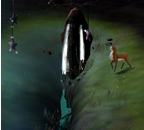
Realtime Art Manifesto
Abstract: Auriea Harvey and Michaël Samyn are new media artists who have embraced realtime 3D game technology as their artistic medium of choice. Realtime 3D is the most remarkable new creative technology since oil on canvas. It is much too important to be wasted on computer games alone. This manifesto is a call-to-arms for creative people (including, but not limited to, video game designers and fine artists) to embrace this new medium and start realizing its enormous potential. As well as a set of guidelines that express our own ideas and ideals about using the technology:
1. Realtime 3D is a medium for artistic expression 2. Be an author 3. Create a total experience 4. Embed the user in the environment 5. Reject dehumanisation: tell stories 6. Interactivity wants to be free 7. Don’t make modern art 8. Reject conceptualism 9. Embrace technology 10. Develop a punk economy.
Keywords: realtime 3d, computer games, interactive storytelling, game design, artistry, non-linearity. Realtime Art Manifesto by Auriea Harvey & Michaël Samyn. [via]
Posted by jo at 12:34 PM | Comments (0)
November 13, 2006
Pong amb la ma
Posted by jo at 04:11 PM | Comments (0)
November 07, 2006
The Play of Imagination:
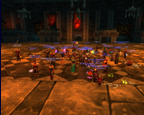
Extending the Literary Mind
"In the past decade, beginning with Ultima Online, a new genre of interactive play has emerged in the form of massively multiplayer online games (MMOGs). These games combine the power of traditional forms of roleplaying games with a rich, textured graphical framework. The result has been the emergence of game spaces which provide players with new and unusual opportunities for learning. As these games become increasingly popular and as they begin to approximate large scale social systems in size and nature, they have also become spaces where play and learning have merged in fundamental ways, where players have become deeply enmeshed in the practices and cultures of interactive play, collaboration, and learning. More important is the idea that the kind of learning that happens in these spaces is fundamentally different from the learning experiences associated with standard pedagogical practice. In this paper, we examine how this new world of games has captured the imagination and how the play of imagination that it engenders yield insights into the way play, innovation, and learning are connecting for the 21st century.
The power of these particular games rests with the way in which they allow players to construct vivid and meaningful “conceptual blends” by taking different worlds (such as the physical and the virtual) and combining them to create new and better ways to understand both the game world they inhabit and the physical world. Where MMOGs differ from other kinds of games is in their deeply social nature. While a traditional “game” remains at the core of MMOGs, the rich social fabric that the game produces blurs many of the boundaries that we tend to expect such as the distinction between the physical and the virtual, the difference between player and avatar, and the distinction between work and play. Further, we argue throughout the essay that the learning that happens in MMOGs is tied to practices, but those practices are not solely the practices of game play or even skills such as resource management. They are, instead, the skills of learning how to use one’s imagination to read across boundaries and be able to find points of convergence and divergence between different worlds to understand their relationships to one another. MMOGs encourage the use of imagination to bridge the gaps and boundaries between worlds to provide a more complete and a more complex understandings of both the virtual and the physical worlds the player inhabits." Continue reading The Play of Imagination: Extending the Literary Mind, Working Paper - September 16, 2006 by Douglas Thomas and John Seely Brown.
Posted by jo at 04:06 PM | Comments (0)
Jane McGonigal

This Might Be a Game
This Might Be a Game: Ubiquitous Play and Performance at the Turn of the Twenty-First Century by Jane Evelyn McGonigal :: Doctor of Philosophy in Performance Studies :: University of California, Berkeley.
This Might Be a Game examines the historical intersection of ubiquitous computing and experimental game design, circa 2001 AD. Ubiquitous computing, or ubicomp, is the emerging field of computer science that seeks to augment everyday objects and physical environments with invisible and networked computing functionality. Experimental game design is the field of interactive arts that seeks to discover new platforms and contexts for digital play. The convergence of these two fields has produced a significant body of games that challenge and expand our notions of where, when, and with whom we can play. This dissertation explores how and to what ends these playful projects reconfigure the technical, formal and social limits of games in relation to everyday life.
To mark the heterogeneity of this experimental design space at the turn of the twenty-first century, I propose three distinct categories of ubiquitous play and performance. They are: ubicomp games, research prototypes that advance the scientific agenda of ubiquitous computing through game design; pervasive games, performance-based interventions that use game imagery to disrupt the normative conventions of public spaces and private technologies; and ubiquitous games, commercial entertainment projects that replicate the interactive affordances of video and computer games in the real world.
I examine seminal games from each of these three categories, including Can You See Me Now? (Blast Theory/Mixed Reality Lab, 2001); the Big Urban Game (The Design Institute, 2003); and The Beast (Microsoft, 2001) respectively. My discussion draws on original gameplay media, design statements, and first-person player accounts. My critical framework is based on close readings of the play and performance values expressed in the founding ubicomp manifestos of Rich Gold and Mark Weiser. I argue that the persistent responsiveness developed by players to potential ludic interaction represents a new kind of critical gaming literacy. The gamers grow to read the real world as rich with ludic opportunity, carefully testing everyday media, objects, sites, and social situations for the positive and negative consequences of inscribing each within the magic circle of play. I conclude by outlining a course for the future study of these categories that is based in the pre-digital games theory of Johann Huizinga, Roger Caillois, and Brian Sutton-Smith. I argue that as the perceived opportunities for digitally networked play become increasingly ubiquitous, game designers and researchers must attend more carefully to the insights of philosophers, anthropologists and psychologists who historically have explored play as an embodied, social and highly consequential ritual, always already grounded in the practices of everyday life.
Download chapters:
1 Introduction: A Ubiquitous Computing Approach to Play and Performance
2 Three Kinds of Everywhere: The Multiple Genres of Ubiquitous Play and Performance
3 Colonizing Play: Citations Everywhere, or, The Ubicomp Games
4 Disruptive Play: Spectacle Everywhere, or, The Pervasive Games
Coming soon:
5 Activating Play: Affordances Everywhere, or, The Ubiquitous Games – Part I
6 Dangerous Mimesis: Simulation and Dissimulation in Alternate Reality Games
7 Power and Superpowers: The Ubiquitous Games – Part II
8 The Collective Play Values of Ubiquitous Games
9 Conclusions: Specifying Play
Posted by jo at 02:39 PM | Comments (0)
November 06, 2006
Mario's Furniture 2

Players Actualized in Real and Virtual Space
Mario's Furniture 2 is an installation and interactive game created by Hillary Mushkin and S.E. Barnet. Instead of sitting on the couch, players have to move the couch, and the whole living room too!
In this wireless environment, viewers become players, physically moving objects of conflicting human and miniature scales, while racing against the camera's ceaseless panning. The opponents' goal is to maintain the illusion of perspective and the integrity of the mise-en-scene within the gaming space. Time and space become mutable in correlation to virtual gaming apparatuses.
The body of the player is actualized in real and virtual space simultaneously. Playing Mario’s Furniture involves strenuous physicality, parodying conventional video games in which avatars are put in peril while players sit on a couch. Mario’s emphasizes how camera and screen effect the construction of social relationships. Players see themselves (and not a stand in) under the camera’s scrutiny, humorously mirroring the absurdity of living within the frame.
Video. See it at TELIC, Los Angeles, until December 2, 2006. Related: the Nintendo Amusement Park aims to build a life-sized game of Super Mario Brothers that you jump through in real space; xBlocks is a mixed-reality video game that you can play on a sculpture and Shigureden: the Nintendo-powered Museum. [blogged by Regine on we-make-money-not-art]
Posted by jo at 09:55 AM | Comments (0)
October 20, 2006
Global Conflict: Palestine
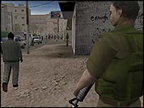
Middle-East Conflict Informs Game
"Global Conflict: Palestine gives the option of three perspectives. A game based in the midst of the conflict in the Palestinian territories is set to be the latest release in the trend of politically-conscious gaming. Global Conflict: Palestine centres on the activities of a young journalist. The player must navigate between different Palestinian and Israeli sources to get to the truth of a story. "You can take a pro-Palestinian angle, a balanced angle, or a pro-Israeli angle," said Simon Egenfeldt-Nielsen, of Serious Games Interactive. Mr Egenfeldt-Nielsen told the BBC's Culture Shock programme: "The game is much more about the personal experience; the emotional experience."
The player walks around a city resembling Jerusalem and its surrounding areas talking to people. As the conflict intensifies, however, the situation becomes increasingly complex and exposes some of the reasons for the ongoing violence ... Different perspectives: Global Conflict: Palestine, which is released early next year, follows music channel MTV's internet-based Darfur Is Dying, which went online earlier this year and had 700,000 players in its first month. Later, tens of thousands of players sent e-mail messages to politicians to urge action over Darfur." From Middle-East Conflict Informs Game, BBC News.
Posted by jo at 04:27 PM | Comments (0)
October 16, 2006
Paul Johnson's
Networked Games
Paul Johnson's work makes use of nonlinear narratives produced by networked video game systems. I design the physical game console and game in tandem. There is usually an operational relationship between the design of the console and the content of the game. I became interested in a joint project with Sunny Kim because notions of constructed realities and dislocation, which run throughout her work, are extremely relevant to many of the issues I confront when developing a video game system. My networked game systems evolve over time. Throughout this process, some of the control of the artist is surrendered to the game system. The premise of Budaechigae is to examine historical mechanisms that inform a relationship between Sunny and myself, and between our respective countries. This relationship is manifested in the Budaechigae video game system and "played out."
Posted by jo at 11:11 AM | Comments (0)
October 14, 2006
Thomas Beard

Interviews Eddo Stern
Interview by Eddo Stern, by Thomas Beard :; Commissioned by Rhizome.org.
Last month at Cinematexas, Eddo Stern unveiled Darkgame (prototype), a videogame installation in which two participants, playing against each other maneuver avatars around a two-dimensional plane, their movements projected against the gallery wall. What's unusual about this scenario is that the experience for both parties involves elements of sensory deprivation. One person is completely "blind," unable to view the main interface and responding only to nonvisual cues: the vibrations of a headset Stern designed to correspond with the location of the opposing player, and related audio signals. And while the other character is able to see the action play out in real time, the field of play becomes obscured when he or she is hit and small patches of gray begin to expand. Sure to open up new avenues for gaming, it's an education of the senses and a truly heady mod.
Well known for his work on such projects as Tekken Torture Tournament, where gamers endured electric shocks relative to the injuries of their onscreen fighters, and Waco Resurrection, in which players assume the role of David Koresh as government authorities advance on the Branch Davidian compound, Stern's art challenges and expands not only our relationships with videogames, but also the social and political histories from which they spring. In this interview, Thomas Beard speaks with Stern about his latest work, as well as MIDIs, memes, and the act of straddling the worlds of art, industry, and internet culture.
Thomas Beard: Let's begin with Darkgame. How did the piece evolve and when did you become interested in this idea of sensory deprivation in gaming?
Eddo Stern: Well, it's an old idea that I've been sitting on for a few years now. Before Waco I wanted to make a game where you can't see but it got sidelined. Eventually it evolved into this new gaming concept that I'm trying to work with, a kind of empirical role-play. In researching my article "A Touch of Medieval," I was getting to this place where role play breaks down: the idea of the "real"-non-roleplaying player, the real character action, how dexterous their fingers are, or how social they are or how aggressive, the idea of real physical and mental abilities versus the idea of role playing, how those aspects of the person eventually come through into a game and what it would be like to build games around these aspects.
Where it happened for me was in Everquest—because I have a really bad sense of direction—and in the early days of that game they made it hard for you to get around. There were no maps, so basically your memory and your sense of direction were all you had. Eventually they developed the Ranger class, and they had this ability called tracking. As a Ranger you would have an extra interface, like a radar you could use to navigate, and for me this was the decisive reason to "roll" that character class, a class that artificially compensated for a physical/mental weakness that I had. I was kind of like a bionic character; suddenly you're experiencing the opposite of what happens in real life—being the guy with the super sense of direction who people ask for directions
Two other big inspirations for Darkgame are certain Paul Bowles short stories—one is called "The Tender Prey," which has to do with torture and exoticism—and JG Ballard's "Manhole 69," which is about a sleep deprivation experiment.
TB: Do you see this particular project moving in new directions?
ES: I'm interested in making it a game that blind people and seeing people, for instance, could play together, a game where the abilities of the blind person would become a benefit in the game, a boon to them, kind of what I was talking about before, the relationships of different types of talents that people have and different types of disabilities that the computer processes into different character types. The game is going to evolve into a 3D game using Torque, which is the same engine we used in Waco, and I'm also going to play around with having the players fluctuate between deprivation and full sensory overload, bombarded by too much information. So for example having them process mental puzzles or challenges or quizzes while performing with hand-eye coordination. That's a part of the game that I'm pretty excited about.
You know Open Mind? It's a research project started at MIT, creating a database of common sense knowledge for an artificial intelligence by feeding it true/false statements, and last I checked they were up to three quarters of a million. Curiously, while I was researching this in the beginning of this year I found another project online called Mindpixel which is basically the same exact project except it's a corporate venture, not attached to a research institute. Something about this idea really hooked into me, and at the time I was using the data from the projects to make up elements of the overstimulation aspect of the game. So while you're playing, for instance, you come up to these big robots or creatures and they start bombarding the players with questions verifying truths from the database. As you're playing the game you need to respond yes-true, false-true and the questions move from being very scientific truths to historical truths to religious truths to truths where you really kind of stop in your tracks.
It also becomes kind of a language poem, this constant staccato of questions, anywhere from: "The universe is expanding. True or false?" to "White is a color. True or false?" So there's this idea of certain sensory deprivation where you will lose your vision as part of the gameplay and you'll lose your hearing and you'll gain this haptic feedback, which is the part that I demoed so far, but you'll also be dealing with this poetic-cerebral layer. Seems very simple at first but before you know it it's a really high computational order, your brain shuts down. I'm interested in stressing the brain, in this case logically, but also on a moral ethical belief level as well with more arbitrary questions about truth and what we know to be true.
TB: Along the lines of sensory deprivation and stress, considering past work like Tekken Torture Tournament and Cockfight Arena, you have a longstanding interest in transforming the experience of gameplay into a decidedly physical one. What do you find significant about those more corporeal aspects of your work?
ES: I think one of the quests for game designers is to enhance the gaming experience beyond these familiar experiences, categories. The idea of action is one that they've always done, the pleasure of action, that's sort of the main genre really. But game designers have gradually expanded the play arena to humor, games that make you laugh, to competition, to social games like The Sims, to nurturing games where you're building things. But for example horror poses a problem where cinematic devices used in horror movies simply don't work in games. I always find that horror games are really not that scary. The idea of genre that's inherited from film in the game design thinking process presents a lot of challenges, like drama or true suspense and horror. And I wanted to see if there's a way to design games that move into psychological realms of horror and suspense, beyond the boundaries of irony and cinematic clichés.
For me one place to reclaim a wider range of experience was to incorporate the body. In a way the body allows for an undeniability of certain emotions, fear is one that I've worked with, as well as surprise, anxiety and embarrassment. Tekken was trying to create an experience that can be quite scary for some people and that really heightens the gameplay. The idea of anxiety and stress in the face of physical harm, and the process of overcoming that, allowed a much more compelling experience for a lot of players. Cockfight was a more casual piece, there's a social element there of course, the physicality of the game allowed for players to really perform beyond the confines of something predefined and preprogrammed.
TB: I was also hoping we could talk about music. In a video like Vietnam Romance, for instance, there seems quite a bit invested in the pop mythologies of the songs you make use of and the powerful sway that the nostalgia they evoke holds over us. What kind of role do you see these soundtracks playing in your pieces, both individually and as a whole?
I use sound in two ways primarily, often simultaneously. I use music ironically and sometimes very unironically, employing their emotional force. Sheik Attack is a piece where the music is central to creating a rift between the more neutral, more mechanized visual footage that you see for most of the video, so most of the footage that's very lo-res is accompanied by very rich, baroque music that has a historical and political significance. At that time it was the most powerful tool I found I could use to metaphorically recreate this relationship between the emotional weight of utopian Zionism and growing up under its powerful ideology, and the reality of manifested Zionism which is much more rough and harsh and harder to come to terms with. The richness and warmth of the music and the cold tinniness of the visuals mirror this relationship and constantly temper each other.
Then in Vietnam Romance it's quite a different relationship because I used MIDI tracks. When you have a very emotional song and then strip out all the lyrics, all the human voice, but leave the melody, your preserve the emotional gush but also introduce a feeling of alienation. Somehow I feel this is the emotion of Nostalgia. Regarding the use of MIDIs, I once saw Alexei Shulgin use them in his show and that really inspired me, his use of a hollowed out emotion, a hollowed out Russian nostalgia for America.
And in the new piece I'm kind of going in a different place with the music. I was at the MacDowell Colony earlier this year and I heard a great musician who was there at the time, Elizabeth Brown. She played a beautiful piece that was Theremin and flute, pure sci-fi emotion, but not in the way that cheesy Theremin music can be. I was overcome by it, and in Darkgame, I am going for a science fictiony, yet politically referenced world. This whole recent history of post 9-11 events feels like science fiction to me. There was something about the way 9/11 happened that was so over the top, so fantastical, as I am sure many people feel, and images from Iraq and Afghanistan are still resonating on that layer, like a giant statue of Sadam being felled is so linked for me to JG Ballard's story "The Drowned Giant."
TB: Exactly, as though the past five years has just been one long alternate history story.
ES: Or the high-tech marine with the laser counter and F16s flying over him riding on a horse in Afghanistan. That was just crazy. The whole conflation is the visual inspiration for me towards the feel of the world that I want to recreate in Darkgame. Elizabeth Brown's music for me is that, a strange connection of science fiction and history—the sort of reality we're experiencing now.
TB: From film festivals to commercial galleries to conferences and seminars of various stripes, you've exhibited in a number of very different forums. Have you been struck by any interesting differences or similarities in how your work has been received or experienced from venue to venue?
ES: Yeah, it's interesting. The art world I think is somewhat aware of gaming art but is really fighting to process it on its own terms—of genre or its historical lineage as fitting it into a movement—and I think pop art is where it ultimately will fall. On the same hand, that fascination with pop exists in a parallel non art-world world, internet meme culture, which to me is really interesting. Recycling icons and mutating them through flash animations and Photoshop and what they now call mashups—All your base are belong to us, Punch a Spice Girl—is totally alive and well on the internet as digital folk art. Tekken was targeted in some ways for that audience, so once we did it we put up a little QuickTime movie and it had gotten picked up by Memepool and Metafilter and Fark and other Slashdot-like sites. It's funny that something like Tekken can work on both worlds at the same time, net meme culture and within a history of body art and performance as well.
Showing Waco at E3 was exciting, having the industry take a look. I think with games there's potentially a more complex relationship than we're used to with, say, products that you buy as gadgets versus fine art objects. The idea of a game busting into a gamer community, a game that's very different from what they're used to but that still adheres to some rules and standards of game design and gameplay technology, that's where I am most happy to be now. I can see game projects like Tekken and Waco and hopefully the new game project feeding back into a much larger awareness of what can be done both with gaming and art.
Thomas Beard is a writer and curator of film and electronic art. From 2005-2006 he was Program Director of Ocularis, a non-profit media arts organization based in Brooklyn. Prior to that he served as a programmer at Cinematexas, and has organized screenings and exhibitions at such venues as Aurora Picture Show, Chicago Filmmakers, MassArt Film Society, Pacific Film Archive, and the Museum of Modern Art, New York.
Posted by jo at 01:17 PM | Comments (0)
Riot Gear for Rollartista
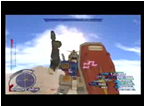
An Action Dedicated to African/Muslim Immigrants
Riot Gear for Rollartista: a blog and mobile gaming performance project by Anne-Marie Schleiner and Talice Lee. This blog is for posting information about a performance action we are doing in Castellon Spain on Saturday October 21, 2006 as part of an exhibition at EACC Espai d'Art Contemporani de Castell from October-January 2007. It will involve three short Machinima (stories told with video game footage) videos that will be beamed from an ultra-light projector stapped to one of our head helmets. (The videos are now linked from the blog to YouTube.) We sampled the two Playstation games Narc and MechWarrior. It sort of evolved into a violent (break) dance musical and each video is dedicated to an African or Muslim immigrant who was seriously abused by police in Spain or France. We, two American women in padded anime/riot gear/something else inspired moda, will be holding Playstation controllers and rollerskating at the same time, (and sometimes dancing), while we coast around projecting onto surfaces of the city.
After the performance/action we will also post documentation videos and photos on the blog.
Posted by jo at 01:01 PM | Comments (0)
October 13, 2006
GameScenes
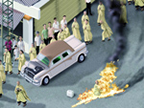
Art in the Age of Videogames
Video and computer game technologies have opened up new possibilities for artistic creation, distribution, and appreciation. In addition to projects that might conventionally be described as Internet Art, Digital Art or New Media Art, there is now a wide spectrum of work by practitioners that crosses the boundaries between various disciplines and practices. The common denominator is that all these practitioners use digital games as their tools or source of inspiration to make art. They are called Game Artists.
GameScenes explores the rapidly expanding world of Game Art in the works of over 30 international artists. Included are several milestones in this field, as well as some lesser known works. In addition to the editors' critical texts, the book contains contributions from a variety of international scholars that illustrate, explain, and contextualize the various artifacts.
ARTISTS: AES+F, Cory Arcangel, Aram Bartholl, Dave Beck, Tobias Bernstrup, Nick Bertke, John Paul Bichard, Marco Cadioli, Mauro Ceolin, Brody Condon, Joseph DeLappe, Delire (Julian Oliver), Todd Deutsch, Micah Ganske, Beate Geissler − Oliver Sann, Brent Gustafson, Jon Haddock, Margarete Jahrmann − Max Moswitzer, JODI, Joan Leandre, Miltos Manetas, Alison Mealey, Mark McCarthy, Shusha Niederberger, Nullpointer (Tom Betts), Nullsleep (Jeremiah Johnson), Totto Renna, RSG (feat. Alexander Galloway), Anne-Marie Schleiner, Eddo Stern, Palle Torsson, UBERMORGEN.COM.
AUTHORS: Matteo Bittanti, Rebecca Cannon, Pierluigi Casolari, Maia
Engeli, Henry Lowood, Sally O'Reilly, Domenico Quaranta, Philippa Stalker, Valentina Tanni.
Text in English and Italian.
Downloadable texts:
Matteo Bittanti: Game Art (Intro): www.gamescenes.org/images/GameArt_eng.pdf
Domenico Quaranta: Game Aesthetics (Outro):
www.gamescenes.org/images/Game_aesthetics_eng.pdf
Valentina Tanni: Geissler – Sann: Shooter:
www.gamescenes.org/images/Tanni_shooter_eng.pdf
More information:
Gamescenes.org: http://www.gamescenes.org/
Videoludica.game culture: http://www.videoludica.com/news.php?category=9
GAMESCAPES: THE SHOW
The release of GameScenes coincides with the launch of GameScapes. Videogame Landscapes and Cities in the Works of Five International Artists, a group show featuring works by some of the most celebrated artists working with digital games: Cory Arcangel, Mauro Ceolin, Jon Haddock, Eddo Stern, and Carlo Zanni.
Monza, September 16, 2006 — The Civic Gallery in Monza is pleased to present GameScapes. Videogame Landscapes and Cities in the Works of Five International Artists. Curated by Rosanna Pavoni with the collaboration of Matteo Bittanti and Domenico Quaranta, GameScapes investigates the notion of digital games, spaces, and urban environments in in our hyper-mediated age. Comprised of paintings, installations, and projections, the exhibition space will be transformed into a real-life gamespace.
Included in the exhibition are a video installation by Cory Arcangel, Super Mario Movie (2004), a series of paintings by Mauro Ceolin from the SolidLandscapes (2004-2006) series, Carlo Zanni’s interactive installation Average Shoveller (2004), Eddo Stern’s recent urban machinima Landlord Vigilante (2006) and the entire series of Jon Haddock’s seminal Screenshots (1999). Most of these artworks have never been presented in Italy before.
Johan & Levi is publishing the GameScapes catalog which features new commentary texts by Rosanna Pavoni, Matteo Bittanti, and Domenico Quaranta.
More information:
Gamescenes.org: http://www.gamescenes.org/
Videoludica.game culture: http://www.videoludica.com/news.php?category=9
Downloadable texts:
Press Release (italian only) -
http://www.clarart.com/mostre/civica/game.doc
Introduction by Rosanna Pavoni -
http://www.domenicoquaranta.net/GameScapes/Pavoni_eng.pdf
City of Bits by Domenico Quaranta (catalogue text) -
http://www.domenicoquaranta.net/GameScapes/Quaranta_cityofbits_eng.pdf
Art Gamers by Domenico Quaranta (panel) -
http://www.domenicoquaranta.net/GameScapes/Quaranta_ArtGamers_eng.pdf
Videogames as a mean of transport by Matteo Bittanti (catalogue text) -
http://www.domenicoquaranta.net/GameScapes/Bittanti_eng.pdf
GameScapes. Videogame Landscapes and Cities in the Works of Five
International Artists
curated by Rosanna Pavoni
Monza Civic Gallery
Monza, via Camperio 1
October 13 – 29, 2006. Free Entrance
From Tuesday to Sunday, 10.00 – 13.00 and 15.00 – 19.00.
Opening: Thursday October 12 from 6:30 PM
email: salecomunali[at]comune.monza.mi.it
Posted by jo at 09:25 AM | Comments (0)
September 27, 2006
Blast Theory at FIRST PLAY BERLIN

Premiere of Day of the Figurines
Blast Theory at FIRST PLAY BERLIN - opens tomorrow: 28.9.06
Day of the Figurines: Be the first to experience Day Of The Figurines - a virtual city where events are dictated by text message. A gig by Scandinavian death metallists. An invasion by a Middle Eastern army. A church fete. Send and receive. React and Interact.
Trampoline are delighted to host the world premiere of renowned British media art group Blast Theory’s new mobile phone game for up to 1000 players. Day Of The Figurines will be on show for 24 days in the Berlin venue Hebbel am Ufer theatre, HAU2, launching on September 28th at 6pm.
Day Of The Figurines is a mass participation artwork using mobile phones that is part board game and part secret society. Set in a fictional English town that is littered, dark and underpinned with steady decay - the game unfolds over 24 days, each day representing an hour in the life of the town. Players choose a figurine to represent them and participate using their mobile phones. Interacting via text messages players receive updates from the town, missions and dilemmas. They can chat to other players who are near them using text messages as events unfold day by day.
Day Of The Figurines is the world’s first MUD (Multi User Domain) for mobile phones and was developed as part of the European research project IPerG (Integrated Project on Pervasive Gaming) and in collaboration with Mixed Reality Lab, University of Nottingham. Following FIRST PLAY BERLIN, Day Of The Figurines will visit the National Museum of Singapore in December 2006 and tour the UK in 2007. For more information about multi-award winning, Bafta-nominated Blast Theory go to www.blasttheory.co.uk
First Play Berlin: Day Of The Figurines kick starts a month of digital art in and around Hebbel am Ufer. FIRST PLAY BERLIN features innovative work questioning the concept of performance and interactive art. Dominated by an artistic process absorbed in understanding location and pervasiveness, the work demonstrates the complexity of our globally connected reality. FIRST PLAY BERLIN is funded by the German Federal Cultural Foundation, British Council, Hebbel am Ufer and Radiator Festival for New Technology Art. For more information about FIRST PLAY BERLIN and Trampoline – the international platform for new media art - go to www.trampoline-berlin.de
Posted by jo at 06:49 PM | Comments (0)
September 25, 2006
Aya Natalia Karpinska

nobody knows but you + interview
nobody knows but you was written for Double-Cute Battle Mode, an application prototype for a VJ (video jockey) remix battle. DCBM allows two players to combine visuals and special effects in a playful competition for screen space. Using joysticks, players plug their imagination into their computer and share a creative space in an intuitive video-game style interaction. The piece was conceived as a way to ease text back into an image-dominated culture by treating it simultaneously as a visual special effect and as a poem.
The twenty-three verses appear on a plane in three-dimensional space. A cube shape displays additional visuals. Both the cube and the plane may be scaled and rotated, and the reader has control over which verse or image is displayed.
You may notice in the image at top left, or while watching the documentation video, a twelve-year-old girl plopped down in front of the installation. She played with the piece on and off for three hours. She began singing the words, making up melodies and turning certain verses into refrains. There is a clear lack of literature that responds to the intellectual and creative needs of young people today. I hope that interactive writing can help to fill that gap.
The original DCBM program was created with Carlos J. Gómez de Llarena.
- Aya Natalia Karpinska, Fall 2005
An Interview with Aya Karpinska on “mar puro” by Rita Raley, Iowa Review, v8 n3 September 2006
RR: How would you characterize your current work in three dimensional text and/or spatial poetry?
AK: This interview comes at an interesting time, when I am having serious doubts about pursuing spatial poetry, at least in the way I have approached it in the past. For one thing, a screen is a screen. It’s not space. The computer screen is a powerful interface, but I believe we are conforming to its demands as users, and not the other way around. I’m looking forward to exploring technology in physical spaces, where people are out and about living their lives. One technology that comes to mind is the mobile phone, which has already surpassed the computer as the digital device of choice for much of the world. Our spatial knowledge comes, of course, from physical space. Now we are out in space with a mini-computer in our pockets. But back to your questions…
RR: This is a general question, but would you be willing to speculate about the significance of the word or letter’s becoming three-dimensional? About what difference it might make for poetry, current paradigms of reading, our understanding of text? What do you find yourself able to achieve that was not possible with previous reading and writing technologies?
AK: With digital screen-based text, one thing that still intrigues me is overlapping. With mar puro and most of my other 3D poems, motion and interaction combine different parts of the text. You can create spontaneous relationships among the words, both as the author and as the reader. I could perhaps achieve a similar effect by printing on transparent sheets and instructing readers on how to move the sheets around, but that is cumbersome. The experience of the digital version is smoother.
As for an effect on current paradigms of reading… this is an important question. How are we going to engage younger audiences that grew up with video games and texting and surfing the Web? With a recent piece of mine, nobody knows but you, I wanted to answer that question by creating a space for readers to perform the text. I essentially placed text on the same level as image, and the reader can manipulate the size and position of each, like a VJ (video jockey). This is certainly not something I intend a reader to curl up with in bed – it’s designed for a club environment or similar social space. Mashing together multimedia and text can make the experience of reading more playful. In John R. Kelly’s concept of play, he emphasizes how we go about it, not just what we do. This is where interactivity comes in, the “how.”
Posted by jo at 07:13 PM | Comments (0)
September 22, 2006
CollecTic

Rediscover the Real World
The game CollecTic by Jonas Hielscher is developed for the Sony Playstation Portable (PSP) and uses existing wireless local area network (WLAN) access points as a main game element.
The game can be played anywhere, where WLAN access points can be found. In the game, the player has to move through the city to search for access points. The access points are visualized on the PSP as basic geometrical figures (triangle, circle, square) with a specific color and sound. Discovered access points can be collected and combined in a puzzle in order to earn points. In CollecTic, the player uses his PSP as a sensor device to discover the hidden infrastructure of wireless network coverage via auditive and visual feedback. By the game the player is stimulate to physically move around and explore his surroundings in a new and playful way.
CollecTic uses existing technology in a new way. It stimulates players to rediscover the real world and the hidden infrastructure of wireless network coverage, rather than creating virtual fantasy worlds as most digital games do. It is an approach to explore the real world and to make existing technology visible and possible to experience.
More information about CollecTic and the game itself (only for PSP firmware 1.5) can be found PixelSix. [blogged by julian on selectparks]
Posted by jo at 06:46 PM | Comments (0)
September 18, 2006
Connecting Worlds

Creative Possibilities of the Networking Age
09.15-11.26.06 :: Connecting Worlds, the first exhibition after the renewal of NTT InterCommunication Center[ICC] focus on the "communication", with contributions exploring the creative possibilities that emerged out of the new environments of the networking age.
'As the first exhibition since the reopening of ICC, this show raises-from the horizons of art and programming-practical alternative possibilities of various phases of communication that we currently see around us. This exhibition features artwork and projects that take a unique step into contemporary networks, politics, economies, physiology, or urban environments by manipulating sound, games, the Internet, or other media as well as foreseeing artwork created in the past.' Yukiko Shikata, curator

cyclone.soc by Gavin BAILY + Tom CORBY, UK 2005 :: CYCLONE.SOC brings together two contemporary phenomena: (1) severe weather, the project uses weather data that charts the emergence and progress of hurricanes; (2) the polarized nature of debate that occurs in certain online newsgroup forums. The project maps textual conversation taken from the political and religious newsgroups to the isobars of a dynamic, interactive weather visualization of hurricanes - whose complex structures are used to visualize the conversational churn and eddies of the newsgroup conversations.
In staging these interactions as a process of meteorological precipitation, newsgroup conversations "condense" in the works environment as a temporal ambient patterning - a structuring that acts not only as a metonym of difference, but of ideological tensions which mirror the dynamics of social space. CYCLONE.SOC is a navigable environment that gives the user the ability to zoom in or out and skate across and through the cyclonic weather formations in order to read or be immersed in the newsgroup text.
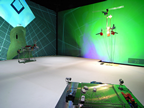
OBJECT B by exonemo, Japan 2006 :: OBJECT B 2006 Yamaguchi Center for Arts and Media (YCAM) YCAM InterLab Installation presenting a modified first-person 3-D shooting game with kinetic objects and a virtual-reality setting. Installed inside the three-dimensional environment created through projections onto all four walls of the exhibition space, are three objects made of keyboards, mice, and other computer parts and electric tools, and a control terminal for players. The robots' (programmed) frequent violent actions trigger automatic commands, according to which the game develops.

MaSS (Market as Speed Spectra) by MaSS Dev., Japan 2006 :: In e-trade, there are cases in which up to 1,000 "ticks" (contracts made when seller and buyer agree on a price are being counted per second?DThis work extracts log data of daytrade, where instantaneous decisions are being made based on numbers displayed on the computer monitor?Cand transforms the speed and rhythm of such transactions into sound and light. "MaSS" likens the steady high-speed exchange of data in e-banking to a worldwide network of reflex nerves.
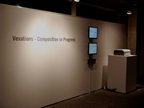
Vexations-c.i.p. (Composition in Progress) by MOHRI Yuko + MIHARA Soichiro, Japan 2005 :: "Vexations - c.i.p.(Composition in Progress)" 2006 transmediale 06, Berlin This work presents "Vexations", an odd piano piece of a single phrase repeated 840 times, originally composed by Erik Satie in the late 19th century, interpreted through an automatic, computer-controlled looping system. While incorporating modifications caused by data of environmental noises recorded with microphones at the venue, the software automatically generates new scores, based on which the piece gradually changes as the performance continues.
Artists include: ambientTV.NET (AT/IN/UK) / Wayne CLEMENTS (UK) / Robert DAVIS + Usman HAQUE (UK) / exonemo (JP) / Peter FISCHLI & David WEISS (CH) / Muntadas (UK/SP) / MaSS Dev. (JP) / MOHRI Yuko + MIHARA Soichirou (JP) / Newtype Technology Lab. (JP) / Dennis OPPENHEIM (UK) / Manuel SAIZ (UK/SP) / TANO Taiga (JP).
Posted by jo at 04:18 PM | Comments (0)
Insectopia:

Context-Aware Gaming
insectopia is a new kind of cell phone game where the real world spills into the game world. Players roam the cityscape searching for and catching a multitude of different insects. Each insects in the game world is generated by using the available bluetooth devices available in the player’s vicinity. By catching insects and trading them with other players, players build their own collection bigger and better. The current status of the game is displayed on various highscore lists both in the phones and online.
See also geoquiz, a location-based mobile game in which players create and answer questions related to their current geographic position (kept track of through the GSM network). [blogged by Nicolas on pasta and vinegar]
Posted by jo at 03:42 PM | Comments (0)
September 15, 2006
Gaming Realities

Virtual Spaces are the New Public Spaces
In less than a month Gaming Realities, one of the biggest festivals to date encompassing the critical exploration of videogames in the fine arts and humanties, kicks off in Athens. The festival hosts a great line up of artists and speakers, many of which we've covered or archived here at Selectparks over the years (Blast Theory, Sir Frasca, Darwinia, Eastwood Group, Molleindustria and many more). I'll be there, so if you're at the festival come to my keynote and ask some impossibly difficult questions when I least expect it. Cheers! Read on for the comprehensive press release and exhbition details. [posted by julian on selectparks]
EXHIBITION: NetODrom by Christoph Anthes, Alexander Wilhelm, Helmut Bressler, Roland Landershamer, Johannes Zarl, Silke Wiesinger; Austria, 2005 :: Can you see me now? by Blast Theory; U.K., 2001 :: Philosopher Death Match by Benjamin Chang; U.S.A., 2006 :: Grid Chase - The 5€ Dance Pad Project by Dimi Christopoulos; Greece, 2002-2006 :: Himalaya’s Head by DEVART; Netherlands, 2005 :: Civilization IV – Age of Empire by Eastwood Group; Serbia, 2004 :: N o w h e r e - ein welt raum spiel by Sylvia Eckermann, Gerald Nestler, Christof Cargnelli, Oliver Irschitz; Austria, 2005 :: Bordergames by Fiambrera; Spain, 2005 :: Postvinyl by Mathias Fuchs; U.K., 2005 :: Lykno by David Gauthier, Henri Marino, Laurie Prevot, Jean Batiste Spieser; France, 2006 :: Semiomorph by Troy Innocent; Australia, 2001 :: Darwinia Introversion Software, U.K., 2005 :: Ready Played by The Ludic Society (Margarete Jahrmann/Max Moswitzer); Austria/Switzerland, 2006 :: Kalamiotou_02 by The mamayans; Greece, 2006 ::
Max Payne cheats only by Jodi; Netherlands :: Ariadne’s Sonic Threadball by Panagiotis Koutlemanis, Dimitris Dinieas; Greece, 2006 :: Façade by Michael Mateas, Andrew Stern; U.S.A., 2005 :: The McDonalds’s Videogame by Molleindustria; Italy, 2006 :: Soviet Unterzogersdorf the adventure game by Monochrom; Austria, 2005 :: Book and Volume by Nick Montfort; U.S.A., 2005 :: The making of Balkan wars: the game by Personal Cinema; Greece, 2004 :: Disaffected by Persuasive Games; U.S.A., 2006 :: Interactive Circus by Prof. Marie-Helene Tramus, Cedric Plessier; France, 2005 :: Jumping Rope by Orna Portugaly, Daphna Talithman, Sharon Younger; Israel, 2004 :: Global Conflicts: Palestine by Serious Games Interactive; Denmark, 2005-2006 :: Boys in the Hood by Axel Stockburger; Austria/U.K., 2005 :: The endless forest by Tale of Tales; Belgium, 2005 :: Game Music by Vladimir Todorovic; Serbia, 2004-2005 :: Fijuu2 by Julian Oliver, Steven Pickles; Germany - New Zealand, 2006 :: Coin Snatch by sheismartha, Alexandros Plakidas Dasios; Greece, 2006 :: History Lost Redux by University of the Aegean; Greece, 2006 ::
Conference Highlight:
The democratisation of virtual environments
Personal Cinema
International New Media Collective
A spectre is haunting Virtual Environments, their democratisation.
It is the spectre of democracy, which after the abandonment of its physical space [real life] sinking more and more in the contradiction of lies and the cancellations that lead to its constitution, it breached the relations with the real and it became itself a spectre. This is how the paradox of spectre occurred, the wandering shadow of democracy. A spectre that tries to penetrate, and aims to democratise the new kind of ghosts that constitute the space which forms a major element of human experience: The Virtual Environments.
The democratisation of virtual environments, computer and video games is one main debate issue in the industry of interactive media. In new media and especially video games the democratisation is related mainly to the fact that the user, in the context of interaction and personalisation, takes major part in the creation process of the games themselves. Mods, thousands of volunteer designers in Half Life, Everquest, Oblivion, and Quake, are examples of how the users participate in the creation process. If we are able to discuss something new in new media it is the user’s capability to participate in the creation process. This capability is not a gift or an offer of a generous democratic technology, but immanence within its own structure, it is an immediate reflection of the conflicts that constitute this capability of participation which has as its final destination democracy.
In other words, speaking of the conditions which arose from the utopian meeting of spectres, which magical ritual could be useful for both the old spectre of democracy and the ‘spectral’ world of virtual environments?
The vast majority of the users understand democracy according to the quantity of interactive “clicks” which represent the voting “right” in cyber space. The image of the voting procedure and democratisation in virtual space isn’t the supposed infinite choice of different web pages or the user’s ability to create personalised narration in a video game; it is the image of the cursor itself over the icon of “choice” accompanied by the sound of the “click” which really is the extension of the image of the poll and the hand that is “capable of choosing”.
How is possible to revive democracy in the realm of the potential, when within the context of the objective it became a commodity that has usually been exported and imported via violence?
Posted by jo at 09:32 AM | Comments (0)
September 14, 2006
Scoot
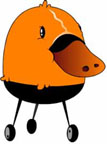
a location-based game
Melbournians have another chance to save their town from those pesky aliens when the location-based game, Scoot, returns this weekend 16 - 18th September.
Following its 2005 premiere at ACMI and Federation Square, Scoot 2006 will be played over 3 days across Victoria's 5 major cultural organisations and takes participants on a unique interactive treasure hunt through the virtual and real worlds of Australian Centre For Moving Image, National Gallery of Victoria, State Library of Victoria, the Arts Centre and Melbourne Museum.
A location-based game that employs sms, multimedia and the online environment to explore concepts of space, Scoot 2006 is played out via sms instructions sent to participants' mobile phones. It begins with players receiving a mystery SOS message leading them to the world of Scoot. In order to avoid invasion, players must then seek out magical characters, play online games and interact with the strange objects that have arrived in Victoria's major arts institutions.
Created by artist Deb Polson and presented by Australian Centre For Moving Image in collaboration with National Gallery of Victoria, State Library of Victoria, the Arts Centre and Melbourne Museum, Scoot explores using mobile phones as tools of play and creates a gaming experience across multiple locations in Australia's largest location-based game. It has been supported by the Victorian Government through Arts Victoria and the Community Support Fund.
Families and groups of 2-6 can play. For more information and to register visit Scoot or ACMI Games Lab [posted by jacinta on selectparks]
Posted by jo at 07:28 PM | Comments (0)
September 08, 2006
Tag Shufflesition:
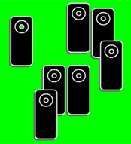
A Mobile Game of Mimicry and Mime
Tag Shufflesition: a mobile game of movement, mimicry and mime, that uses iPod Shuffles to see how fast can you find out who’s “it”! :: Designed by Charlie Hoyt and Andrew Bucksbarg, Indiana University Bloomington (2006) :: Central Park, New York :: Saturday, September 23, 2006 at 3:00PM.
Christo may have turned Central Park into a work of art, but Andrew Bucksbarg and Charlie Hoyt are part of a group of game designers who will be transforming New York into an enormous game level. Mobile and locative technologies have given rise to an international flowering of what are called urban games, street games or Big Games. These games explore new technologies and make the real world and urban spaces their playground. Tag Shufflesition will be featured in New York’s Come Out & Play Festival
From massive multi-player walk-in events, scavenger hunts to public play performances; the festival will give players and the public the chance to take part in a variety of different games. The festival will feature the innovative use of public space and games that make people interact in new ways, such as Tag Shufflesition.
Tag Shufflesition is a mobile system for movement and dance using the random playback feature of mobile mp3 players, such as Apple’s iPod Shuffle. The “Shufflers” (participants) receive random instructions from their iPods as to how to move and interact with the other Shufflers. One iPod is loaded with a slightly different set of instructions. The task of the Shufflers to find out which Shuffler among them is “it”- the one with the different instruction, and begin to mimic all of the “it” Shuffler’s movements. The game is complete when all of the Shufflers are correctly mimicking the “it” Shuffler.
Tag Shufflesition is engaging for both spectators and participants as an interactive game of patterns movement and mimicry. Shufflers will enjoy following the directions, which often exist as small games within the larger game of Tag Shufflesition. Spectators, without the distractions the Shufflers face, will also enjoy trying to guess who’s “it,” but please don’t give “it” away!
Charlie Hoyt is an Audio Instigator. When he’s not staring at a mixing board or making “music”, Charlie enjoys video games, rock ‘n roll, and name-dropping. Charlie is pursuing a Masters in Immersive Mediated Environments at Indiana University in Bloomington, Indiana, studying audio and music for participatory media. Charlie’s previous artistic fracases include “ToneBeast”, which received honorable mention at the 2004 Indiana IDEAS Fest and “MESS”, which received nothing, but is nevertheless fun. Email: audioinstigator(at)yahoo(dot)com
Andrew Bucksbarg is a techno-media artist, experimental interaction designer, audio-visual performer and a professor in the Department of Telecommunications at Indiana University. Bucksbarg’s work and interests reverberate in the space of creative new media practices, technology and theory. As an experimental interaction artist, Bucksbarg concerns himself with technologies and social systems that support tactics of ambiguous, autonomous social creativity and exchange. Bucksbarg’s work appears physically and digitally around the globe, including the Rhizome.org Artbase; Share DJ, NY; The 2006 Bent Festival, NY; National Museum of Australia, Canberra, Australia; Sonorities Festival, Belfast, UK; The Dark light Film Festival, Dublin, Ireland; Trampoline Media Festival, Nottingham, UK and dLux Media Arts Festival, Sydney, Australia. Email: Andrew(at)adhocarts(dot)org Press: 812-219-5310
Posted by jo at 04:37 PM | Comments (0)
September 06, 2006
See You in Walhalla
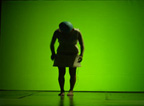
World Premiere of Live Computer Game
[Posted by Yukihiko YOSHIDA] World Premiere of new Live Computer Game "See You in Walhalla" :: September 14, 2006 :: IME Industrial Performing Arts Complex - Athens (Greece) and two other European cities (Sofia and Amsterdam) connected live through the Internet.
The Athens based performance group amorphy.org, with support of the Cultural Center of Kifissia and the EU Culture 2000 Funding Scheme, is proud to present the world premiere of "See you in Walhalla," a distributed live performance game connecting three cities – Amsterdam, Athens and Sofia. This multi-media dance/theatre project, collaboratively created by artists and designers from four different European partner sites in Greece, The Netherlands, Germany and Bulgaria, presents the unusual journey of a video game “avatar” through a haunted urban industrial landscape composed of digital fragments from the spectacle of Europe.
The audience in Athens is invited to witness the exciting premiere of the first live 3D computer game enacted by three dis/located performers simultaneously, with Ermira Goro playing the “avatar” on location in Athens, while Nancy Mauro-Flude and Ivaylo Dimitrov are streamed via web-cams into the game but are located in Amsterdam and Sofia respectively, and watched by local audiences in those cities. At the same time, “See you in Walhalla” can be witnessed live on the Internet, where online players can log on to offer their comments and reactions to the performance/game. The Athens premiere represents the first leg of a European tour scheduled for 2006-2007 seasons.
Description of the new work:
An average man. Slightly obsessive, familiarly lonely. He eats his green apples, rendered phosphorescent in the glow of his computer screen. A new video game, See You in Walhalla – “in this place everyone who is not in jail works for the police.” He creates his avatar. The game’s purpose - to guide this avatar, born as an “empty” shell, through various journeys taking place in an imaginary city-scape morphed out of Amsterdam, Athens and Sofia, with the final goal of rendering the avatar into a more “human being”, capable of surviving the density, danger and psychosis of urban existence, at a time when Europe is undergoing its own nightmares of economic and political integration. Paradoxically, integration in this haunted and visually disturbing game is experienced as a series of physical and psychic dis-sociations. The Player gets more involved with the game, losing a sense of reality and becoming more socially autistic, while his avatar slowly recovers a sensibility for human inter-action which is punished by the pressures and regulations, as well as the hyper-euphoric spectacular image-scapes, of which the urban rhythms of existence are determined.
I am Amalia, if you hurry me I will say I am Molly, I am her, locked up in the big house, desperate, pursued by Rosas’s mazorca, I am Irish, I will say then, I am her and I am also the others, I was the others, I am Hipolita, the gimp, the little cripple, I tottered slightly when I walked, Hipolita, I say to him, and he smiles, Hipolita, with “the gloves on her small hands”, she ran away with the psychopath, the big castrated psychopath who could tell the future on Tarot cards, he had a scar on his groin from here to here.
Three performers inter-connected, a complex web of fantastical events seen from pre-recorded film, live-web cam and audio streams from Amsterdam and Sofia, interactively controlled sound and video based determined by movements of the performer in Athens, and unpredictable site-specific performances in Sofia and Amsterdam – these components compose the 3D live game environment which promises Player and Avatar a life after death (Walhalla).
The protagonist of this game is not an ego-shooter, but a flâneur, a cyber wo-man who discovers herself as an anonymous face in the multitude, but who is free to probe her surroundings for clues and hints that may go unnoticed by the others. The Avatar-wanderer does not abandon herself/himself in the crowd, but actively participates, observes, revolts, and intervenes in her surroundings, and just as she experience her “unbearable lightness of being”, she is nearly killed in an accident.
This theatrical computer game explores the “system” of deadly possibilities that lurk in the entropic cities of late capitalism, amongst the facades of glamour, heroic icons and consumer fetishes which, like a dream, do not exist in reality or can fall apart in a moment, setting fire to the outskirts of our imagination or flooding our delusional consciousness.
* * *
Initial Concept by: Tzeni Argyriou, Ioanna Tsinividi, and Ash Bulayev
Tzeni Argyriou (Concept and Direction); Zoe Chatziantoniou, Ioanna Tsinividi, and Ash Bulayev (Creative Team); Tzeni Argyriou, Zoe Chatziantoniou, Ermira Goro, and Ash Bulayev (Choreography); Ioanna Tsinividi (Video Direction/Editing); Zoe Chatziantoniou and Ash Bulayev (Dramaturgy/Text Composition); Stavros Gasparatos (Music Composition); Arjen Keesmaat and Stoycho Stanchev (System Design/Programming); Paul Verity Smith (Sensor Development); Kostantinos Kipriotakis (Stage Design); Sakis Birbillis (Lighting Design); Despina Makarouni (Costume Design); Nikos Makris (3D Animation); Christopher Brellis (Designer); Lena Kitsopoulou and Ash Bulayev (Voiceovers)
Web interaction design and logistics by: Sher Doruff (Waag/Holland), Johannes Birringer (InteraktionsLabor/Germany), and Galia Dimitrova (InterSpace/Bulgaria)
Performed by: Ermira Goro (Athens), Nancy Mauro-Flude (Amsterdam), and Ivaylo Dimitrov (Sofia)
Production Crew:
Maria Kerasioti (Lead Project Facilitator/ C.C. of Kifissia), Maria Ladaki (Project Coordinator/C.C. of Kifissia), Eleni Katsarou (Project Coordinator & Production Manager/amorphy.org), Galia Dimitrova (Project Coordinator/InterSpace), Johannes Birringer (Project Coordinator/InteraktionsLabor), Floor Van Spaendonck (Project Coordinator/de Waag), Dyonisis Petrouchopoulos (Director of Photography), Katerina Stasinopoulou (Co-Video Editor), Christopher Brellis/antidot (Web-Design/Poster Design), Guy Stefanou (Technical Director)
Logistics:
Date: September 14th, 2006
Time: 21:00 (Athens/Sofia) & 20:00 (Amsterdam)
Locations:
Athens/Greece (IME Industrial Complex, Building 5)
Amsterdam/Netherlands
(Waag Society, Nieuwmarkt Square)
Sofia, Bulgaria
(Red House for Culture & Debate,
15 Ljuben Karavelov Street)
Info: www.amorphy.org/imap
* For press photographs or any other information regarding the show or project, please contact: info[at]amorphy.org
Development History
With funding support of the European Culture 2000 Framework Program, the project development of “See you in Walhalla” began in September 2005, and after extensive filming on location and digital choreography and computer programming workshops in the various partner sites , the new work will be shown as a live networked performance on September 14th, 2006 in Amsterdam, Athens, and Sofia. The collaborative project, implemented through a trans-European network of four participating media art organizations, is dedicated to fostering new and innovative works of art through effective integration of interactive technologies and live performance practices.
Collaborative Network of Co-Organizers
· amorphy.org (Athens, Greece) - www.amorphy.org
amorphy.org is a non-for-profit organization devoted to production of original works of live performance and installation, through constant pursuit of practical investigation fusing media art technologies and live performance practices.
· InteraktionsLabor (Göttelborn, Germany) – www.interaktionslabor.de
InteraktionsLabor, under the direction of Johannes Birringer, is an organization which focuses on research in communications technologies, interactive media, performance and virtual environments.
· InterSpace (Sofia, Bulgaria) – www.i-space.org
InterSpace is a New Media Art Center that works for the establishment of a social attitude to new media art forms, through the development of alternative means and possibilities of artistic expression in new media technologies.
· De Waag (Amsterdam, Holland) – www.waag.org
Waag Society for Old and New Media is a knowledge institute operating on the cutting edge of culture and technology in relation to society, education, government and industry, established in 1994.
· Cultural Center of Kifissia (Athens, Greece) - www.kifissia.gr
C.C. of Kifissia various courses for painting, Greek traditional dancing, theatre, jewelry , photography, batik, mosaic and so on. The municipal cultural centre highly supports and promotes cultural creativity.
Associated Partners
PACT Zollverein - Essen, Goethe Institute, Red House For Culture and Debate, IKS, IME Research Facility, Ipsilon Production Company, Brunel University, i-DAT/University of Plymouth.
ash bulayev/amorphy.org
artistic director
Address:
Alopis 58, Kato Petralona
11853 Athens Greece
email: ash[at]amorphy.org
web: www.amorphy.org
mobile: + 30 6937 20 33 00
work: + 30 210 34 56 341
Posted by jo at 08:18 AM | Comments (0)
August 28, 2006
Playback_Simulated Realities

The Impact of Re-Enactments on Society
Playback_Simulated Realities :: 3 September - 5 November 2006 :: Opening: 2 September 2006, 7 p.m. :: Participating Artists: Ant Farm and T.R. Uthco, Christoph Draeger, Omer Fast, Beate Geissler/Oliver Sann, Lynn Hershman, Felix Stephan Huber, Eddo Stern, Milica Tomic, Susanne Weirich.
Public interest in elaborately staged history spectaculars which are supposed to bring the past to life as realistically as possible by virtue of faithful adherence to detail continues to grow apace. The form used for re-enacting political events and milestones of world history is also increasingly shaping approaches to art. Forms of 're-enactment' and simulation occur above all in the context of the new technologies. The exhibition "Playback" investigates the influence and impact re-enactments and simulations have on society. It raises questions about the function of the digital substitute worlds developed in computer games in satisfying viewers' needs. It discusses the yearnings for authentic experience which are also addressed in reconstructions of past eras. In a 'society of spectacle', which only values reproduction, it raises the question of whether we can still trust our own experiences and memories and, if so, to what extent.
What changes take place when historic events are retold? The works shown in the exhibition examine in reconstructions and stagings how experiences and memories are at once individually experienced and culturally construed.
The Eternal Frame, a video by the Ant Farm and T.R. Uthco group, is a critical commentary on the globally reknown images of the assassination of John F. Kennedy disseminated by the mass media that has engraved themselves on our collective memory. Christoph Draeger's Black September restages the terrorist attack that claimed eleven victims at the 1972 Munich Olympic Games; fact and fiction, past and present are so intricately interwoven that the boundaries between documentary and real experience are blurred. In his video Spielberg's List, Omer Fast deals with the construction of, and response to, the past, describing the casting process and what the cast of the Holocaust film "Schindler's List" by Stephen Spielberg experienced in making the film.
Return to Veste Rosenberg by Beate Geissler and Oliver Sann plunges viewers into a computer game that has become reality. Pictures of soldiery deployed in a medieval fortress alternate with fairy-tale shots of enigmatically phantasmagoric figures from a different time. In her documentary feature film Strange Culture, Lynn Hershman relates the dramatic events which changed the life of artist Steve Kurtz when the FBI, after the tragic death of his wife, suspected his art activities as an act of eco-terrorism. In the video Vietnam Romance, Eddo Stern investigates the influence of mass-media images on public perceptions of wars and shows images from computer games that recreate the representation of the Vietnam War in Hollywood films. In the computer installation Ops Room by Felix Stephan Huber, the player is caught up in the simulation of an historic place. What is staged is the celebrated control room realised in Santiago de Chile by the cyberneticists Stafford Beer and Fernando Flores in 1972, which was intended to be used as an instrument for computer-controlling the interventionist socialist economy under Salvador Allende.
In Container, Milica Tomic has succeeded in creating a memorable link between questions of identity and memory, personal and political history. Dependencies and power politics experienced by members of a capitalist society are subjected to radical criticism in this video and slide show, in which she refers to the issue of human beings as wares. In Silent Playground, Susanne Weirich stages six film sequences, which borrow the logic and setting of computer games. Matching the binary strategy of such games, each filmic sequence has a good and a bad ending.
Events: Friday, 8 September, 8 p.m. :: Sir Drone (1989) by Raymond Pettibon :: Filmscreening within the scope of the Oldenburger Filmfestival
A catalogue will be published.
Guided Tours: every Sunday, 3 p.m.
17 September and 22 October: guided tour by Sabine Himmelsbach
Edith-Ruß-Haus für Medienkunst
Katharinenstraße 23, 26121 Oldenburg
t. +49 (0) 441 - 235 3194, http://www.edith-russ-haus.de
Posted by jo at 03:24 PM | Comments (0)
August 24, 2006
The Pong Dress

Body as Screen
The little black dress as erotic playground for pong? Max Moswitzer and Margarete Jahrmann alias Marguerite Charmante of the Ludic Society (and of the Nybble Engine fame) have crafted a Pong Dress to dissolute the boundaries between body and screen.
White LED's shine through the black front of the dress. At hip level, two retro-game consoles are offered to players to play Mini-Pong on a 5x7 LED screen worked into the dress. Two pixels move up and down as rackets to the left and right along the waist. With every achieved point, the green score display blinks at chest level.
Hit the dot back and forth with two sticks - this time all new on a 3D playing field, that is moving, chatting and laughing. we hit the dot with some spin from the height of the belly button and aim at the left nipple.
Check it at the Pong Mythos exhibition that just opened in Leipzig. More images.
The dress was inspired by Valie Export's Tap and Touch Cinema, 1968, in which the artist, a box attached to her naked chest, invited pedestrians in several European cities to "visit the cinema".
Via Selectparks. Related: Dress, a polypropylene dress fitted with small "counters" which offer glimpses of human flesh for "sale"; One ball, two bats and our life in a digital world. [blogged by Régine on we-make-money-not-art]
Posted by jo at 02:13 PM | Comments (0)
August 18, 2006
Darfur campaign in Second Life
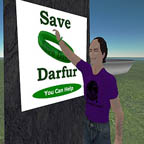
Embedded Social Messages
Darfur_Campaign [originally uploaded by eliane_alhadeff] (Rubber bracelets have made it into virtual life, as have hairy arms. Amazingly weird.) I found this on Flickr, and I'm rummaging around to find out what was going on - there was an interesting, Star-Wars style committee meeting for this online kidscamp project - maybe? - and a game has been produced, one of many to be produced by teens, each with a message:
Playing 4 Keeps is an innovative youth media project, in which a team of Global Kids Leaders at South Shore High School are gaining leadership and game design skills that they will use to develop and produce a socially conscious online game each year.
This is seriously impressive stuff.
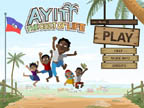
High quality, solid message:
Ayiti: The Cost of Life is a role-playing video game in which the player assumes the roles of family members living in rural Haiti. Over the course of the game, the player must choose among and balance various goals, such as achieving education, making money, staying healthy, and maintaining happiness while encountering unexpected events. The player must make many decisions that contribute to or detract from achieving his or her chosen goals.
Global Kids Digital Media Initiative - lots of interesting, game-based political and cultural activities, produced by and for teens,
SaveDarfur.org - the campaign [blogged by Alice in Wonderland]
Posted by jo at 03:34 PM | Comments (0)
August 15, 2006
Serious Games:
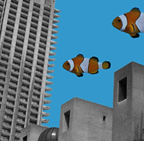
Understanding the Grey Area Between Learning and Playing
Michael Magee and Owen Brierley talked about how game playing is always already a learning experience - along the lines of Steven Johnson's Everything Bad is Good for You.
Serious Game Initiative "The Serious Games Initiative is focused on uses for games in exploring management and leadership challenges facing the public sector. Part of its overall charter is to help forge productive links between the electronic game industry and projects involving the use of games in education, training, health, and public policy."
Serious Games: Improving Public Policy through Game-Based Learning and Simulation
Serious Games Summit 2006
Serious Games Canada
Canadian Game Studies Association
Interesting stuff, but I would have loved to hear more critical discussion of military games and the civilianisation of technology. Someone brought up Pax Warrior - an interesting twist on the war game based on the absolutely tragic experiences of General Roméo Dallaire in Rwanda, where Canadian peace-keeping forces were abandoned by the UN and were not able to stop the genocide of hundreds of thousands. (If you haven't seen Shake Hands With The Devil, I highly recommend it.) My concern is not just with the skills that can be learned in serious games, but the values too. Mia asked about activist games or games for social change, but the panelists pointed out that their value depends on who is trying to do the indoctrinating or resocialising. [blogged by Anne Galloway on Purse Lips Square Jaw]
Posted by jo at 07:04 PM | Comments (0)
July 26, 2006
Game/Play presents

Abiogenesis
The Game/Play team are pleased to present: An online performance by Tale of Tales - Auriea Harvey and Michael Samyn, in The Endless Forest :: Thursday July 27th 7.00pm – 8.00 pm (BST) :: Free, all are welcome :: To play: Download the Endless Forest 'social screensaver'.
Come and meet us online within the live, real-time world of 'The Endless Forest'. "The Endless Forest by Tale of Tales is a game about beauty, wonder, calm and peace. There are no stealth missions, no guns to swap, no armour or enemies. Taking on the role of a somewhat dreamy deer who wanders through an endless forest imbued with magical powers that seem as unpredictable as mesmerising, players of The Endless Forest are invited to hang out and roam amidst beautiful trees, old mysterious ruins, an idyllic pond and happy flower beds. Without a goal of any sorts, they soon find that there’s more to the forest than just mere eye candy." Maaike Lauwaert & Martijn Hendriks. Read full text.
"In keeping with Wirefire, an earlier project involving a series of intimate live, online performances on the theme of love, the artists intermittently appear as the ‘gods’ of the Endless Forest. Using a system they call Abiogenesis the virtual woodlands become a mutable stage for the artists’ performances." Ruth Catlow & Marc Garrett. Read full text.
The touring Game/Play exhibition is currently showing at Q Arts, Derby and HTTP, London.
Posted by jo at 01:53 PM | Comments (0)
July 18, 2006
Battleship:GoogleEarth
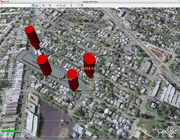
(a 1st Life/2nd Life mashup)
I've started working on a bit of summer laboratory experiment to see how Google Earth could become a platform for realtime mobile gaming. (Follow the link on the Flickr photo page to the URL you can load in your Google Earth client to see the game board in its current state.) With Google Earth open enough to place objects dynamically using the tag, a bit of SketchUp modeling and borrowing an enormous battleship model that construction dude uploaded to the SketchUp/Google 3D Warehouse, I started plugging away at a simple game mechanic based on the old Milton Bradley Battleship game.
Battleship, for those of you who never played, has a simple mechanic — two players set up their navy ships on a peg board, hidden from the other guy. You take turns plugging a peg into your side of the board, with each peg hole designated by a letter/number coordinate grid. When you plug a peg in, you say where you put it — E4! If your opponent has a ship in that coordinate (or part of one, actually), they say, sorrowfully, "Hit!" and you register that peg hole with a color to indicate a hit. If not, you just put in a neutral peg to remind you that you already tried that spot. The game continues into one player has sunk all the other guys ships.
The mechanic I'm experimenting with is simpler. One person places their ships using Google Earth and the other person goes out in the normal world with a mobile phone, a GPS connected to the mobile phone. The phone has a small Python script on it that reads the GPS and sends the data to the game engine, which then updates the Google Earth KML model showing the current state of the game grid. When the player who's trying to sink the ships wants to try for a hit, they call into the game engine and say "drop". The game reads back the coordinates at which the "peg" was dropped and shortly thereafter, the other player will see the peg appear at the coordinate it was dropped. If the peg hits one of the ships, it's a Hit, otherwise it's a miss.
Next Steps
As I continue developing the engine, I'll probably have the game engine let you know when you call in to do the "drop" whether it was a hit or not, or the opposing player can text or call to indicate the same.
I want to put in a "ping" command for the call-in battleship control center to help whoever's wandering around in the world navigate a bit. (Although the game is only really practical if you limit the boundaries over which it can be played.)
I need a lighter weight battleship — the current SketchUp model is too large, in data size terms and takes too long to initially load (although, it only needs to be loaded once.)
Goals
* Experiment with "1st Life" action reflected in "2nd Life" worlds (verso of the folly Ender suffered in Orson Scott Card's simply fascinating Ender's Game
* Learn KML
* Learn SketchUp
* Learn Python for S60
* Make a mobile/pervasive game in which one has to move around in order to play
Equipment
* Google Earth client
* Apache+Tomcat+MySQL (Java and JSP on the server-side computer)
* Nokia N70 and a little Python app to connect to the Bluetooth GPS and upload the data to the server
* Voice Application (for the battleship control center to drop/ping)
* SketchUp
Time Committed: * About 2 days learning stuff, and 1/2 a day programming the computer to make it do things.
Why do I blog this? To keep track of and share the near future laboratory experiments I'm doing this summer.
Technorati Tags: mobile, pervasive electronic games, pervasive media, play, urban play
[blogged by Julian Bleecker on research techkwondo]
Posted by jo at 08:22 AM | Comments (0)
July 03, 2006
State of Play

Life in the Metaverse
State of Play III: Social Revolutions is the third annual conference on the future of cyberspace, from a legal perspective. Convened by the Institute for Information Law & Policy at New York Law School, the Information Society Project at Yale Law School, and the Berkman Center for Internet and Society at Harvard Law School. This year, the conference focused on social relationships in the metaverse and how to build vibrant, flourishing, creative places.
The 2003 conference "State of Play I: Law, Games and Virtual Worlds," introduced the emerging legal, economic, cultural and sociological issues in three-dimensional computer environments. Participants from a variety of different disciplines discussed the impact of virtual worlds on real world law and the rise of law in virtual worlds. Papers explored avatar rights and virtual world identity, among other topics centered on the legal aspects.
"State of Play II: Reloaded" highlighted two themes: the role of intellectual property and governance in virtual worlds. Should we import copyright and trademark into virtual spaces? Can we exclude them? What should be the relationship between real and virtual world economies? Should legislatures protect virtual world property? What are the possibilities for using virtual spaces to practice the activities of real world democracy? Should virtual worlds be treated as separate jurisdictions with their own evolving norms and forms of dispute resolution? What is the potential for using virtual worlds to promote democracy and self-governance?
Archives include video documentation from all three conferences.
Posted by michelle at 01:02 AM | Comments (0)
June 15, 2006
Doing Virtually Nothing

Awareness and Accountability in MM Online Worlds
"Abstract: To date the most popular and sophisticated types of virtual worlds can be found in the area of video gaming, especially in the genre of Massively Multiplayer Online Role Playing Games (MMORPG). Game developers have made great strides in achieving game worlds that look and feel increasingly realistic. However, despite these achievements in the visual realism of virtual game worlds, they are much less sophisticated when it comes to modeling face-to-face interaction. In face-to-face, ordinary social activities are “accountable,” that is, people use a variety of kinds of observational information about what others are doing in order to make sense of others’ actions and to tightly coordinate their own actions with others.
Such information includes: (1) the real-time unfolding of turns-at-talk; (2) the observability of embodied activities; and (3) the direction of eye gaze for the purpose of gesturing. But despite the fact that today’s games provide virtual bodies, or “avatars,” for players to control, these avatars display much less information about players’ current state than real bodies do. In this paper, we discuss the impact of the lack of each type of information on players’ ability to tightly coordinate their activities and offer guidelines for improving coordination and, ultimately, the players’ social experience." From Doing Virtually Nothing: Awareness and Accountability in Massively Multiplayer Online Worlds by Robert J. Moore , Nicolas Ducheneaut and Eric Nickell. [via pasta and vinegar]
Posted by jo at 08:33 AM | Comments (0)
June 14, 2006
Matthew Slaats

My Name is Madison
Taking Madison, WI as its subject, My Name is Madison is an Augmented Reality Game that allows users to explore and interact with the urban landscape from a multitude of perspectives. This project approachs the city as a layered environment. Players understand the development of place through the eyes of history, culture and fantasy.
Using GPS enabled hand held computers, participants take on the roles of both recipient and creator, performance in context. While walking about the streets, they are provided with information that enhances their understanding of the environment and then gives them the tools to create their own interpretations of place. Documentation of these events will be posted to mynameismadison.
The project opens as a part of the Games, Learning and Society Conference taking place in Madison, WI, June 15-16.
Posted by jo at 12:28 PM | Comments (0)
June 12, 2006
de Pong Game™

PONG Augmented/Recycled
De Pong Game is a recycling of the famous game PONG [Atari 1975-1977]. This new version has been built with Flash [Action Script] by Arjan Westerdiep for Recyclism™. De Pong Game explores the concept of Augmented Reality by using and interacting with urban architectures [buildings] as background for the game; the game is projected on a building and the limits of that building become the limits of the game area.
The projected ball bounces along the limits of the walls. The software also uses the windows as obstacles for the game. So the ball is limited to the frame of the building. As you touch the ball with the slider, its speed increases, and because the ball bounces on all the obstacles of the architecture, it becomes more and more difficult to play. [Related: Space Invaders]
Posted by jo at 03:20 PM | Comments (0)
June 08, 2006
Space Invaders 2006

Isn't Just a Fictional Space
Video game, as an interactive medium, has been designed for many different purposes such as education, entertainment, advertising and etc. What makes a game compelling as an experience in order to satisfy different purposes is the purpose of Space Invaders 2006. "Space Invaders 2006 " -- by Evan Barba and Kuan Huang (aka Hawk) -- is a public video game which isn't just fictional space that the players escape into but takes the advantage of a real world space with the architecture inside and transforms them into a game playground. Basically, "SI 2006" is a video game which is projected onto a building. The player controls an aircraft by moving his/her body in the space to shoot down the invaders before they move off the building.
Keywords: Outdoor projection, Video game, Architecture, Motion capture [Quicktime video] [via pasta and vinegar]
Posted by jo at 09:37 AM | Comments (0)
Perlin's Law
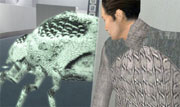
How Free Do We Want to Be?
"...For a long time now, I’ve been struggling with a conundrum of interactive storytelling that I dubbed “The Problem of Internal Consistency” in a lecture I gave at the Game Developers’ Conference in 1995. I also wrote about it in an earlier Designer’s Notebook column, “Three Problems for Interactive Storytellers,” back in 1999. The essence of the Problem of Internal Consistency is this: how do we balance the player’s desire for freedom with the designer’s desire to tell a consistent, coherent story? What do we do when the player wants to do something that doesn’t work with the plot that we’ve laid out? Refuse him permission to do it, and take away his freedom? Or allow him to do it, and destroy our story? I never came up with a good answer for it.
So last November, I went to a conference called Virtual Storytelling ’05 in Strasbourg, France. It was a small enough conference that every session was plenary—you didn’t have to choose between sessions, so as long as you showed up, you were bound to hear everything. Ken Perlin was one of the speakers, and in the middle of his lecture, he made an almost throwaway remark that really brought me up short. This was what he said, the thing that I think is so important:
Ken Perlin’s Law: The cost of an event in an interactive story should be directly proportional to its improbability..." From The Designer's Notebook: Introducing Ken Perlin's Law by Ernest Adams, Gamasutra. [Via Game + Girl = Advance]
Posted by jo at 08:22 AM | Comments (0)
June 05, 2006
Book Review
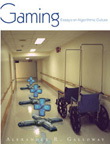
Gaming: Essays on Algorithmic Culture
Review of Alexander R. Galloway's Gaming: Essays on Algorithmic Culture by Thomas Beard, commissioned by Rhizome.
The literature of video games is a curious one. Ranging from Martin Amis's all but forgotten debut, Invasion of the Space Invaders -- a compendium of hot tips for arcade classics like Defender -- to the coin-op psychologizing of Charles Bernstein's "Play It Again, Pac-Man" and beyond, it somehow manages to encompass at once the enthusiasms of that British belletrist and analyses from every imaginable clique of critical theory. Different as those two camps might be, a recent addition to this growing body of work, Alexander R. Galloway's Gaming: Essays on Algorithmic Culture, has drawn from both. An NYU professor, media theorist, and founding member of Radical Software Group (RSG), Galloway states from the outset that his is a book "about loving video games," setting him firmly apart from the more clinically-minded of his peers. That said, the book is hardly the stuff of fanboy effusion, but rather a skillful address to the broad intellectual histories of gaming and a likely source of new debates.
Beginning with the idea that video games are actions, as opposed to traditional forms of image or story, Galloway attempts to outline a poetics for the medium. Much like the film scholars of previous decades, making their case about the unique qualities of the art they treasured, he situates the study of games as needing new conceptual frameworks, new models of thought, presenting a four-part schema to outline the nature of action within them. He claims that the medium¹s most fundamental relationships exist between two axes, that of the operator-machine on the one hand, and the narrative world of a game‹its diegesis‹and exterior properties, on the other. Simply put, each quadrant translates to one type of action. There are diegetic-machine acts, ambient rustlings where the game is running without operator input (day turns to night, a fireplace crackles), nondiegetic-operator acts like setting preferences or choosing weapons, diegetic-operator acts like moving or firing those weapons, and finally nondiegetic-machine acts, which include both disabling acts like 'game over' and network lags as well as enabling acts like power ups. Structured with an Aristotelian rigor, these categories could prove quite pertinent to the future of video game criticism, accounting as they do for the cybernetic dynamism so basic to the experience of gameplay.
Equally thoroughgoing is Galloway's history of the first-person shooter, whose roots he traces through a study of subjective camerawork in film. Citing such examples as Notorious' drugged-up Ingrid Bergman, Robert Montgomery's failed noir experiment, Lady in the Lake, and the knife-wielding predators of Psycho and Halloween, he positions the perspective as almost exclusively marginal within cinema, frequently used to depict mental affection, detachment, or monstrosity. Of course, according to Galloway, there is one exception to this otherwise awkward way of seeing, the cyborg. He argues that we view the subjective POV of Robocop and the Terminator, all bleary video and cursor prompt, as more acceptable than that of a character in, say, Dark Passage precisely because conflating the machine of the camera with an already mechanized body makes for a far less dubious pairing than with that of a human. So it's through a movie like Predator that Galloway sees a link, aesthetically speaking, to video games, where the first-person perspective is hardly marginal. Instead, it's quite crucial to the vision, the action of play. "Where film failed," he writes, "games succeed." A thoughtful mapping out of Marshall McLuhan's proposal about finding old media in new ones, the essay points toward the larger project in digital aesthetics, a quest of origins.
Traditional notions of realism are parsed in a similar fashion, revealing their unique relevance to gaming. Looking outside the verisimilitudes offered by ever-increasing polygon counts, Galloway considers gaming "a third moment of realism," after those based in image and narrative. Since the gamer is required to act, not simply look or read, Galloway sees the realism of a game as inextricably bound to the social context in which it is played. "Any game that depicts the real world must grapple with this question of action," he maintains, positing that America's Army, despite its high-end design, is actually not realist insofar as it's disconnected from the lived realities of the vast majority who play it. Games like Under Ash, however, by setting their conflicts within the Israeli occupation, are occasions for genuine realism, at least by the Palestinians who play them, if not others.
Theories of allegory are also revised and updated by Galloway in what is perhaps the most provocative essay in the collection. Following Gilles Deleuze and expanding some of the ideas in his earlier book, Protocol, he contends that video games are consummate expressions of what it means to live in a network society. Deleuze saw the highway as epitomizing a major phenomenon of late twentieth century culture, allowing endless mobility that was nonetheless entirely controlled. So too with video games, Galloway argues, which, despite appearing to offer a liberating smorgasbord of option and outcome, simply hide the lateral system of information control that characterizes contemporary existence. Unlike earlier, "deep" allegory, as typified by forms like cinema, what Galloway calls "allegories of control" are not ideological manipulations, but a complex process of masking new forms of control as an escape from older ones. Though I wonder about this last point, and the limits it places on the possibility of alternative play.
By centering a means of control in the deep-seated architectures of gaming, Galloway recalls older critiques of Hollywood. He puts forth, for instance, that a seemingly progressive update of the imperialist Civilization would still be subject to the same regulatory principles as the original. In much the same way, certain theorists in the seventies saw narrative film of all stripes as a political dead end. Outlandish as the claims of Laura Mulvey and company might look now, they instigated critical dialogue that was nothing short of vital; perhaps Galloway's article will do the same.
The book then closes, appropriately enough, with a discussion of counter-gaming, something of a new media analogue to counter-cinema, a la Peter Wollen, in which Galloway considers the work of artists like JODI, Cory Arcangel, and Anne-Marie Schleiner. But no matter how virtuosic their respective manipulations might be, for Galloway, a true avant-garde of video games is still ahead of us. Moving beyond a dominant preoccupation with visual elements, he ends by calling for creative intervention into more basic concerns: "We need radical gameplay, not just radical graphics." Such a statement leads one to think about what the future holds for video game criticism as well. Who will be the Greil Marcus of Mario? The Sontag of Shenmue? The Hoberman of Halo? Those are all questions that will no doubt answer themselves in coming years, but, given his project of analyzing the poetics of these particular social forms, one might say already that, in Galloway, the medium has found a contender for its Fredric Jameson.
Thomas Beard is the Program Director of Ocularis, a non-profit media arts organization based in Brooklyn. He has also served as a programmer at the Cinematexas Film Festival, and curated screenings and exhibitions at such as venues as Aurora Picture Show and the Museum of Modern Art, New York.
Thomas Beard
Program Director
Ocularis
at Galapagos Art Space
70 North 6th Street
Brooklyn, NY 11211
http://www.ocularis.net
Posted by jo at 10:43 AM | Comments (0)
May 22, 2006
PerGames 2006 Papers + Slides

Workshop on Pervasive Gaming Applications
The PerGames series of international workshops addresses the design and technical issues of bringing computer entertainment back to the real world with pervasive games.
:: Pervasive Game Flow: Understanding Player Enjoyment In Pervasive Gaming :: Mobile Device based Interaction Patterns in Augmented Toy Environments; slides :: Talk & Demo Smart Playing Cards – Enhancing the Gaming Experience with RFID; paper :: Participant Roles in socially expanded Games :: Haptic Feedback In Pervasive Games :: ’ERE BE DRAGONS: Heart And Health
:: Talk & Demo Multimodal Multiplayer Tabletop Gaming; paper
:: Talk & Demo PAC LAN; slides; videos
:: Marker-Based Embodied Interaction for Handheld AR Games
:: Exploiting seams in mobile phone games; slides
:: Report about the crossmedia game Epidemic Menace
:: Demo The Mogile Platform
:: Relying on Wireless Sensor Networks to Enhance the RC-Gaming Experience
:: Systematically Exploring the Design Space of Location-based Games
:: Exploring the Usability of Video Game Heuristics for Pervasive Game Development
:: Wanderer
:: An RFID-based game to encourage social interaction
[blogged by nicolas on pasta and vinegar]
Posted by jo at 09:22 AM | Comments (0)
Virtual Sumo

Virtual Energy
Virtual Sumo is inspired by sumo, the Japanese sport in which two contestants try to force their adversary outside the competition area or make him touch the rug. The attack in preceded by a phase of mutual observation (shikiri) in which the fighters use eye contact, study and strategic ploys to make their opponent lose concentration. In this phase it seems that even slight changes on the exposed areas of the contestants’ skin would allow both opponent and audience to judge the state of fighter’s emotions.
In the Virtual Sumo installation two fighters, seated at a table with a monitor set so that they are obliged to assume a position similar to that used in sumo, rest their left hands on a sensor that records the state of their emotions (heartbeat and surface perspiration). On the monitor the competition area can be seen, a circle in which two game pieces represent the two contestants; their emotional state is also visualized, moment by moment. The contestants can thus check on the screen their own and the other’s state of concentration and, given the proximity of their face to that of their opponent, can use disturbing stategies.
The more emotionally neutral their state of mind is, the more their (virtual) energy grows. When they think the moment has come, by pressing a button with their right hand they launch the attack: The piece that represents them flings itself at the opponent’s piece tryng to throw it out of the circle. On the wall above the two contestants a large screen will dramatically reveal the alternation of the two fighters’ emotional responses.
By Mario Canali, Yaniv Steiner, Massimo Banzi, Gabriele Gotini, Leonardo Aurelio, Massimiliano Cavigioli, William Giroldini and Studio Canali S.r.
Similar games of relaxation: BrainBall, Wave UFO, Relax to win, InnerForce, and Wild Divine. [blogged by Regine on we-make-money-not-art]
Posted by jo at 08:06 AM | Comments (0)
May 09, 2006
toy game doodle

social collaborations as play
The Benetton Interactive Department Research Centre, FABRICA, recently developed Benettonplay, an online game site exploring play as a form of expression and communication. "We believe that putting people into new kinds of creative and playful relationships with each other is itself an important statement."
Play is now a central part of our cultural life. Interactive gaming has grown into an enormous global media industry. Playing together on computer or console is one of the key ways we know ourselves and each other. We believe that play is too important to be left to shoot 'em ups and driving sims. We believe that the meaning of a game is not what it says directly, but in how it helps players find new ways to be together and to speak to each other.
Posted by michelle at 02:20 AM | Comments (0)
August 08, 2004
Noderunner

Racing Against Time
Noderunner--by Yury Gitman, Carlos J. Gomez de Llarena--is "a competitive game (that) fuses the streets with wireless networks to convert the city into a playing board. Two teams racing against time must log into as many modes as they can and upload photographic proof to the server, documeting their progess." Noderunner won the Golden Nica for Net Vision/Net Excellence at Prix Ars 2003. Read more
Posted by jo at 04:02 PM | Comments (0)

